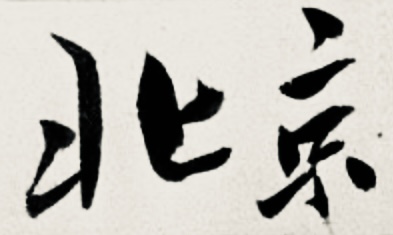Xi Jinping’s Empire of Tedium
Chapter VIII
中軸
On 27 July 2024, the 46th session of the World Heritage Committee in New Delhi, India, announced that ‘Beijing Central Axis: A Building Ensemble Exhibiting the Ideal Order of the Chinese Capital’ had been inscribed on the UNESCO World Heritage List. It was China’s 59th World Heritage Site.
Flying in the face of expert opinion, the advice of architects and popular opposition, the Chinese party-state had damaged, dismantled and desecrated the central axis of Beijing 北京城中軸線 for nearly five decades. The ‘central axis’ of the city that has been inscribed on the UNESCO World Heritage List is a modern confabulation articulated by the post-revolutionary Communist Party to reflect its imperial self-image.
We mark 1 October 2024, the seventy-fifth anniversary of the founding of the People’s Republic of China, with:
- 1 October 2024 — Beijing Reoriented
- The Long Tail of 1644 in 2024
- The Banquet of History
The first of these was originally presented as the opening address at the biannual conference of the Chinese Studies Association of Australia in Brisbane on 27 June 2007, a speech prepared under the aegis of a research project titled Beijing as Spectacle. The two other essays, ‘The Long Tail’ and ‘The Banquet’, draw on my book The Forbidden City which appeared with Profile Books in London and Harvard University Press in 2008. None of this material has previously been available in digital form.
In my remarks to the Chinese Studies Association, titled ‘Beijing Reoriented, an Olympic Undertaking’, I noted, with tongue only partly in cheek, the fortuitous connection between Zhang Yimou, designer of the 2008 Beijing Olympics that focussed the world’s attention on the central axis of late-dynastic Beijing and Adolf Hitler, as well as the consanguineal shade of Albert Speer père et fils.
The overlapping of Zhang Yimou and Hitler was twofold. Both had made designs for Puccini’s opera Turandot (Zhang Yimou’s production was successfully staged at the Ancestral Temple in the Forbidden City in 1998; while Hitler never got further than drawing a stage design for the opera during his pre-Nazi young-artist phase of his life) and both had their Olympics (Zhang Yimou designed the opening and closing ceremonies of the 2008 Beijing Olympics; while Hitler had officiated at the event in 1936, when the first large contingent of Chinese athletes had participated in the games.) The overall design and pageantry of Hitler’s Olympics was the handiwork of Albert Speer, in-house architect of der Reichskanzler.
However, the Berlin-Beijing nexus offered further gems for, in the lead-up to 2008, the Chinese authorities had consulted Albert Speer Jr., Albert’s son, who drew up a plan to re-orient the capital. Eventually, his vision found partial realisation in the re-articulation of the ancient north-south access of the city, one that now starts with a reconstructed pint-sized Yongding Gate in the south and reaches a watery full stop at the Dragon Lake north of the main Olympic venue. This design for ‘Super Beijing’, as it was mockingly dubbed, featured dramatically in the ‘Footsteps of History’ 歷史的足跡 fireworks display designed by the pyro-artist Cai Guo Qiang that was ignited along the city’s spine on 8 August 2008 (see China’s Flat Earth: History and 8 August 2008, China Quarterly, 197, March 2009).
As I observed in my remarks in June 2007, although Speer Sr.’s grandiose plans for Germania, envisioned as the world capital following an inevitable Nazi victory in WWII, were never realised, perhaps their animating megalomania finally found an expression in what I called the ‘vestiges of the Speer-family vision’. It was a vision that also brought to fruition the forty-year long war of attrition suffered by the old city of Beijing that had been launched by the Communists in 1948 (see Dai Qing, 1948: How Peaceful was the Liberation of Beiping?).
Responding to my speech, a senior academic who had been invited to offer a vote of thanks — a chap with a German-Jewish lineage of his own — pointedly prevaricated over what presumably right-thinking people would justifiably regard as my tasteless and inapposite comparisons. Despite the fact I had long been inured to the displeasure of my self-appointed betters, let me assure readers of China Heritage that I was not indulging in some ad hominem reductio ad Hitlerum argument, nor had my decades-long engagement with China finally ended up in the cul-de-sac of Godwin’s Law. (See Beijing, 1st July 2021 — ‘It was a sunny day and the trees were green…’.)
Indeed, I would note that a few years after I delivered my speech in Brisbane, Australia, in Beijing Xi Jinping would be transfigured into China’s party-state-army Chairman of Everything, a leader celebrated as The Sole Vessel 一尊. His China Dream would be to forge The China Race 中華民族 into a homogenous whole, no matter the cost to individual ethnic groups, and the territorial ambition of his New Era is to absorb the independent country of Taiwan. The agenda is national socialism, one pursued by corralling the entrepreneurial spirit, quelling dissent, tireless lawfare, the violent repression of regional disquiet, the promotion of a cult of martyrdom, harnessing the heart-minds of the young and extolling consumerism over citizenship. The Chinese version of ‘One People, One Realm, One Leader’ — Ein Volk, ein Reich, ein Führer — has a familiar ring to it, doesn’t it, comrades?
***
So, as the Communist rulers in Beijing celebrate their from-victory-to-victory odyssey on 1 October 2024 in a city reoriented along imperial lines, I choose to reiterate my understanding of overlapping histories, replicant personality types, dark proclivities and unspeakable propensities that I touched on in remarks made in 2007. Caveat lector.
Although revised for publication, the following text retains traces of its origins as an illustrated talk. We start our ‘Tiki Tour’ of Beijing with a poem by Zhang Lifan, an independent historian based in Beijing. He published this bitter four-line verse following the July 2024 UNESCO announcement that Beijing’s long-disrupted urban axis had been awarded heritage status.
We conclude with some observations by Xu Zhiyong, a prominent rights lawyer jailed under Xi Jinping, regarding Xiong’an New District, a Beijing-adjacent model city announced in 2017. As an ancillary capital Xiong’an is envisaged as embodying China’s ultra-modern hi-tech future (see Xiong’an is Xi Jinping’s pet project, The Economist, 18 May 2023). Xu Zhiyong outlined his scepticism shortly before being jailed.
— Geremie R. Barmé
Editor, China Heritage
1 October 2024
***
On Beijing
- In Search of Old Peking, L.C. Arlington and William Lewisohn, with an introduction by Geremie Barmé, Hong Kong; New York: Oxford University Press, 1987
- The Forbidden City, London: Profile Books and Harvard University Press, 2008
- The Invisible City, China Heritage Quarterly, Issue 14 (June 2008)
- The Rings of Beijing
- 1948: How Peaceful was the Liberation of Beiping?
- China’s Flat Earth: History and 8 August 2008, China Quarterly, 197, March 2009
- Beijing, 1st July 2021 — ‘It was a sunny day and the trees were green…’
Marking China’s National Day
In China Heritage Quarterly:
- March 2009 — Thirteen National Days
- June 2009 — The First National Day
In China Heritage:
- 2017 — The Best China
- 2018 — Homo Xinensis Militant
- 2019 — Writing Home on China’s Seventieth Birthday
- 2020 — The innocent cry to Heaven. The odour of such a state is felt on high.
- 2021 — Celebrating Dai Qing at Eighty
- 2021 — Commemorating a Different Centenary — Dai Qing on the 1911 Revolution
- 2022 — October 1 & October 10 — Two Chinas, Whose Fatherland?
- 2023 — 1 October 2023 — Golden Millet Dreams and a Future Long Frustrated
帝京城郭盡凋殘,作秀申遺枉自歡。
故址重修無永定,危樓新築豈天安。
國門基上殭屍卧,陵墓碑前魅影單。
造夢誰知了夢處,煤山老樹久孤寒。
A city of despoiled crenellations brazenly celebrates undeserved world heritage status[1],
On the old site, an imposter Yongding Gate is built[2], even Tiananmen can offer no peace[3].
That embalmed corpse straddles the nation’s doorstep[4], a ghostly spectre haunting the spot[5].
Who knows what dreams will truly be realised,[6] that solitary tree on Coal Hill has long stood in wait[7].
Notes: [1] Despite the heated opposition of the noted architectural team of Liang Sicheng and Chen Zhanxiang in 1950, the Communist government spent two decades demolishing Beijing’s grand Ming-dynasty walls; [2] Yongding Gate was demolished on the advice of Soviet urban planners in 1957. A scaled down ersatz version was built on the site in 2003. Here the poet mocks on the name of the gate — Yongding 永定 — ‘forever fixed’; [3] Considered to be structurally unsound and a potential danger to Mao, Tiananmen Gate was secretly demolished and rebuilt out of concrete from December 1969 to March 1970. Here the poet asks how such a counterfeit ‘Tianan’ 天安 could vouchsafe true ‘peace under Heaven’ 天安; [4] The original gate to the Imperial City 皇城 — variously called Great Ming Gate, Great Qing Gate and China Gate — was demolished in 1959 and the Mao Mausoleum with the dead chairman’s embalmed corpse its sole inhabitant was built on the site in 1976; [5] A reference to the Monument to the People’s Heroes that pierces the heart of Tiananmen Square; [6] Xi Jinping is not the only one with a China Dream; and, [7] Coal Hill, also known as Prospect Hill 景山, is just north of the Forbidden City. After rebels breached the walls of the Ming capital in 1644, the Chongzhen emperor hung himself from a pagoda tree 槐樹 on the eastern side of the hill. In the late-Xi era, pointed references to the fall of the Ming and the ‘bent-neck tree’ 歪脖子樹 of Chongzhen have been commonplace.
— translated and annotated by GRB
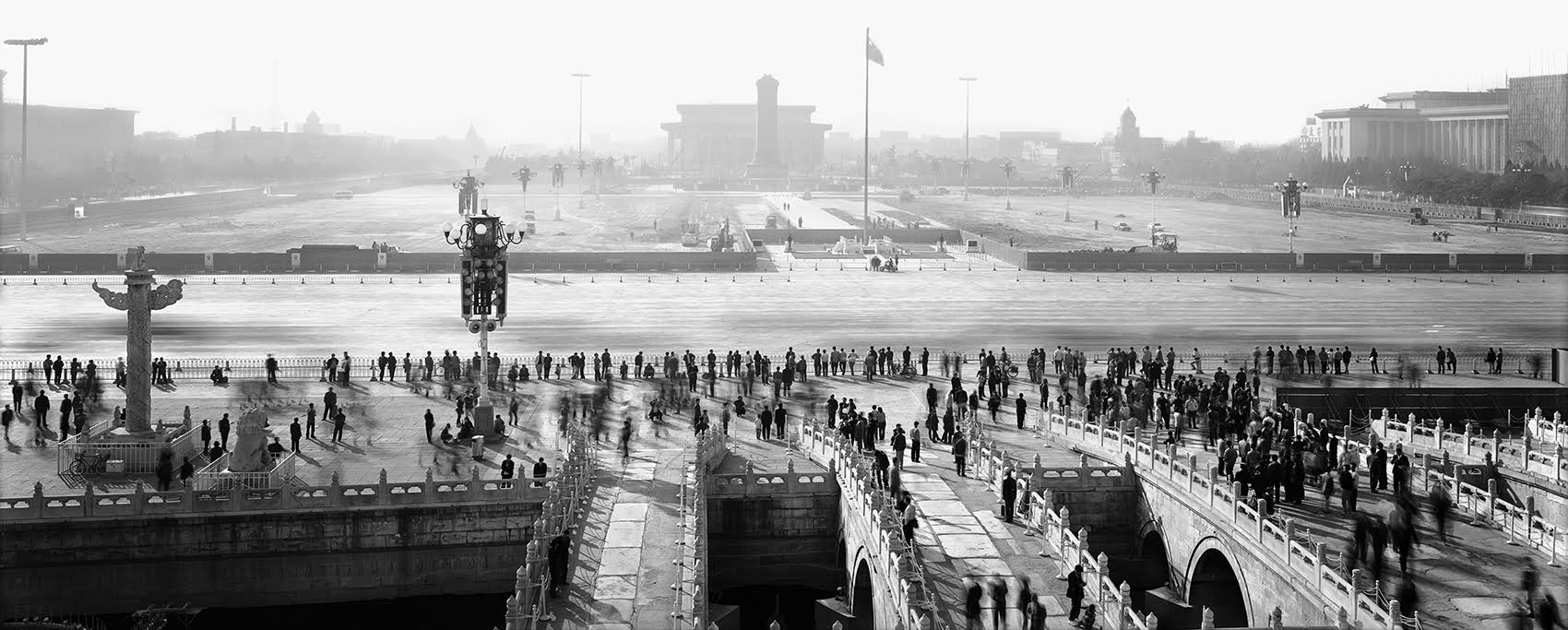
***
Beijing Reoriented, an Olympic Undertaking
Geremie R. Barmé*
The Body of Nezha
It is the mid-1890s. The young Hunan reformist Tan Sitong and a group of his heroic followers arrive on horseback in a cloud of dust at Taoran Ting 陶然亭, the Pavilion of Delight, in the southwest of the Chinese imperial capital. Another reformer, the firebrand Liang Qichao, is already there and the place is crowded with others who have come from all over the city. Tan reports to his bewildered colleague:
These last few days, people have been saying that something peculiar is happening here. There are reports of roaring from beneath the ground; it is said to sound like the bellowing of bulls.
The unsettling sound was not made by a submerged bull. It was the stirring of a restive dragon, one that had long been hibernating under the city. The beast was not the Napoleonic dragon of China that, once woken, would shake the world. Rather it was a curmudgeonly and grumpy old beast agitated by the feverish goings on above ground. The dragon under Beijing was, literally, being unsettled by untoward events: the increasing corruption of the dynastic Qing court, the incursions of foreign invaders and the harrowing destitution of the common people.
***

***
Tan Sitong is surprised to find so many of his friends gathered at Taoran Ting. But they are not there to investigate subterranean rumblings; they are planning a commotion of their own. They are in the midst of setting up the Society for the Strengthening of Study 強學會, a group that will agitate for the political and economic reform of the moribund Qing empire.[1] In 1898, their efforts will contribute to the famous Hundred Days Reform 戊戌變法, an attempt by the Guangxu Emperor to remake the political, educational and social landscape of imperial China. Today it is just 110 years since that movement failed, resulting in the beheading of reformers like Tan Sitong and the slide of Chinese empire towards its collapse a little over a decade later.
In the early 1500s, Zhu Di 朱棣, the Yongle Emperor, had the dynastic capital of the Ming dynasty moved to Beijing. To do so he had the old city of the Mongol-Yuan rulers redesigned and expanded. Legend has it that during the planning of the new imperial capital, the soothsayer Liu Bowen reported to the emperor that the feared dragons lurking in the waters of the place would bring calamity if they were not pacified. These water-hungry creatures that lived throughout the lakes and marshes of the area threatened to steal the precious resource.[2] It is said that one day, while absorbed in his thoughts, Liu was visited by the boy-god Nezha 哪吒, who offered a solution.
A playful deity with eight-arms, Nezha flew on wind-fire wheels, like roller-blades, and wielded monster-defeating hoops. He was famed for having killed the son of the Dragon King, thereby curtailing the power of the aqueous lust of the dragon. Nezha told Liu Bowen that if the new walled city of Beijing was designed using his body for its layout, the dragon in the depths would remain quelled and imperial prosperity would be assured.
According to this legend, Liu Bowen oriented the city so that the gates of imperial Beijing would correspond to Nezha’s arms and legs. The front gate, or Qian Men and its enceinte, is Nezha’s head, the side gates his ears and the wells just inside it his eyes. The two northern gates of Anding Men and Desheng Men are his feet, while the two temples outside the gates represent the wheels of fire and water on which the playful spirit traversed the heavens.
***

***
The red colour of the imperial city itself represented Nezha’s costume, and the halls and pavilions inside the Forbidden City represent his inner organs. The three lakes of Zhongnan and Bei Hai (literally, ‘central, south and north seas’) were his stomach, and the Dragon King who lorded it over the area is said to have dwelled here.[3] Keeping the dragon under control was not only about containing reptilian malevolence, however, for each year the subterranean creature was said to lift its head—龍抬頭, ‘the dragon raises its head’—bringing spring and summer rains, thereby replenishing the underground waters that fed the wells of the city.
With the new walled city of Beijing in the form of Nezha’s body, the dragon beneath it remained in hibernation through to the late-nineteenth century. But then it would stir, aware that the spell cast over it by the body of Nezha would soon be broken. It is said that the threat of the unruly dragon would eventually arrive from the north to steal the precious water on which the city survived. Perhaps, then, it is no accident that directly to the north of old Beijing a new dragon has taken shape, with the site of the 2008 Beijing Olympics in its scaly embrace. The tail of this new and imperious serpent—the Dragon Lake of the Olympic Park—curls around the main Olympic stadium (Herzog and de Meuron’s National Stadium), known as The Bird’s Nest 鳥巢.
***

***
Reorienting Beijing
Regardless of the resurgent dragon in the northern suburbs of Beijing, Nezha has been struggling to retain his integrity for a long time. The twentieth century saw his legendary body put on the rack time and again by urban planners. Their efforts have reflected attempts to remodel, ideologically and physically, the inhabitants of the city and, by extension, China itself. Even during the last years of the Qing dynasty, which collapsed in 1911, the celestial geometry of Beijing was being reordered. Warfare during the Boxer Rebellion of 1900 saw the first despoliation of walls within the city, and subsequently those grand crenulations were breached for the convenience of modern transportation.[4]
***

***
After the fall of the Qing, the world of the abdicated Xuantong Emperor Puyi would literally be turned on its head, as was the north-south axis of the imperial capital itself. No longer would the Son of Heaven leave the Forbidden City through its imposing southern-facing gates at Wu Men, Duan Men and Tiananmen. Having been occupied by the new republican government and a preparatory Palace Museum (initially called the ‘Gallery of Antiquities’), the southern precincts of the palace were now entirely off-limits to the defunct court. Henceforth, the emperor had to use Shenwu Men, the northern entrance of the palace, to make his exit.
***
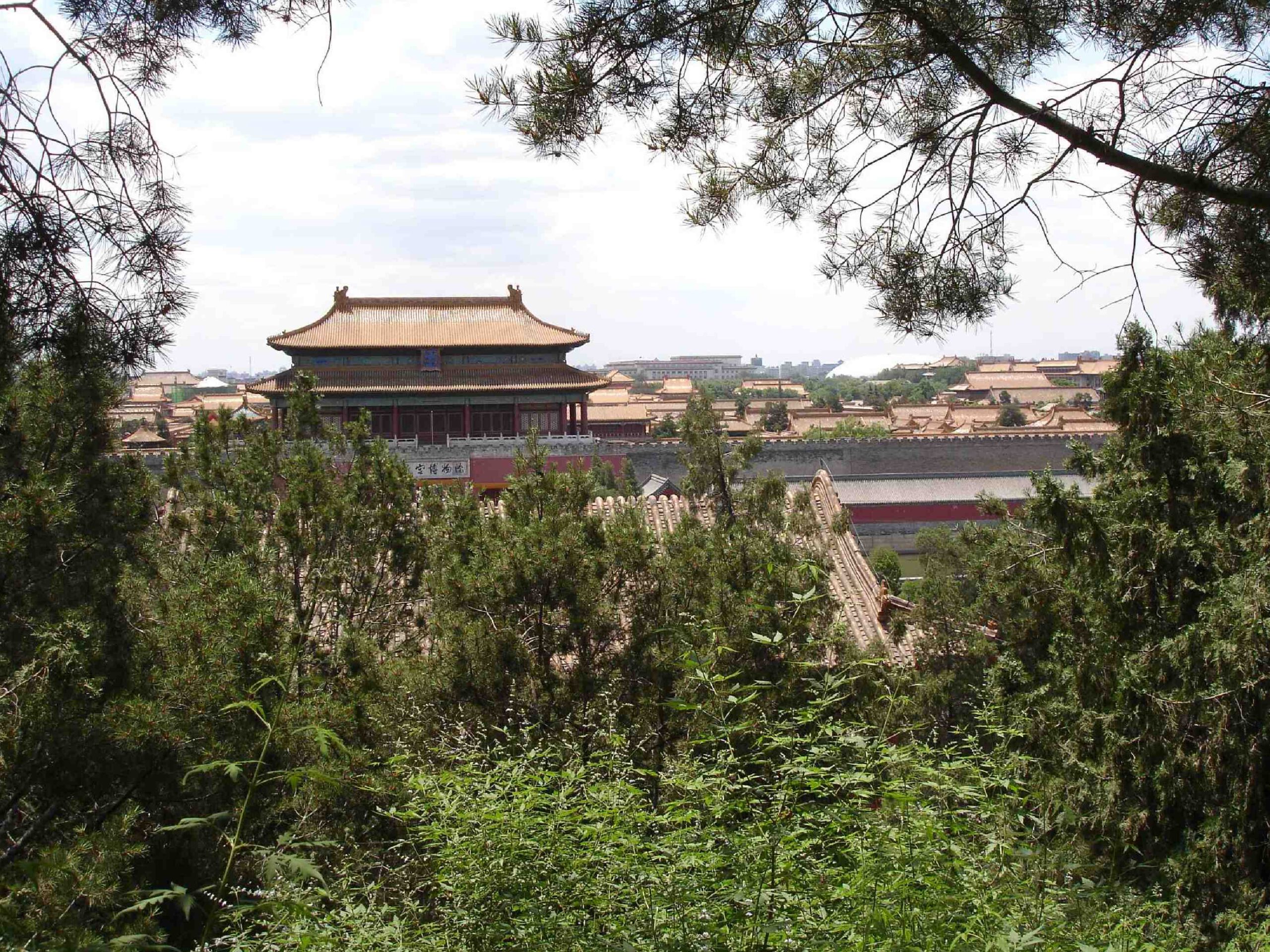
***
Meanwhile, the seat of political power was relocated to the Lake Palaces of Zhongnan Hai. These had been a favourite residence of the Empress Dowager Cixi, the effective ruler of China, in her later years. Both she and the Guangxu emperor died in the Palaces’ pavilions within a day of each other a century ago. In the early Republican era that replaced their rule in the 1910s, these palaces would be used as the seat of government by Yuan Shikai,[5] a martial president who would be emperor. The Chinese Communist Party and the State Council still rule the nation from the Lake Palaces today.
***
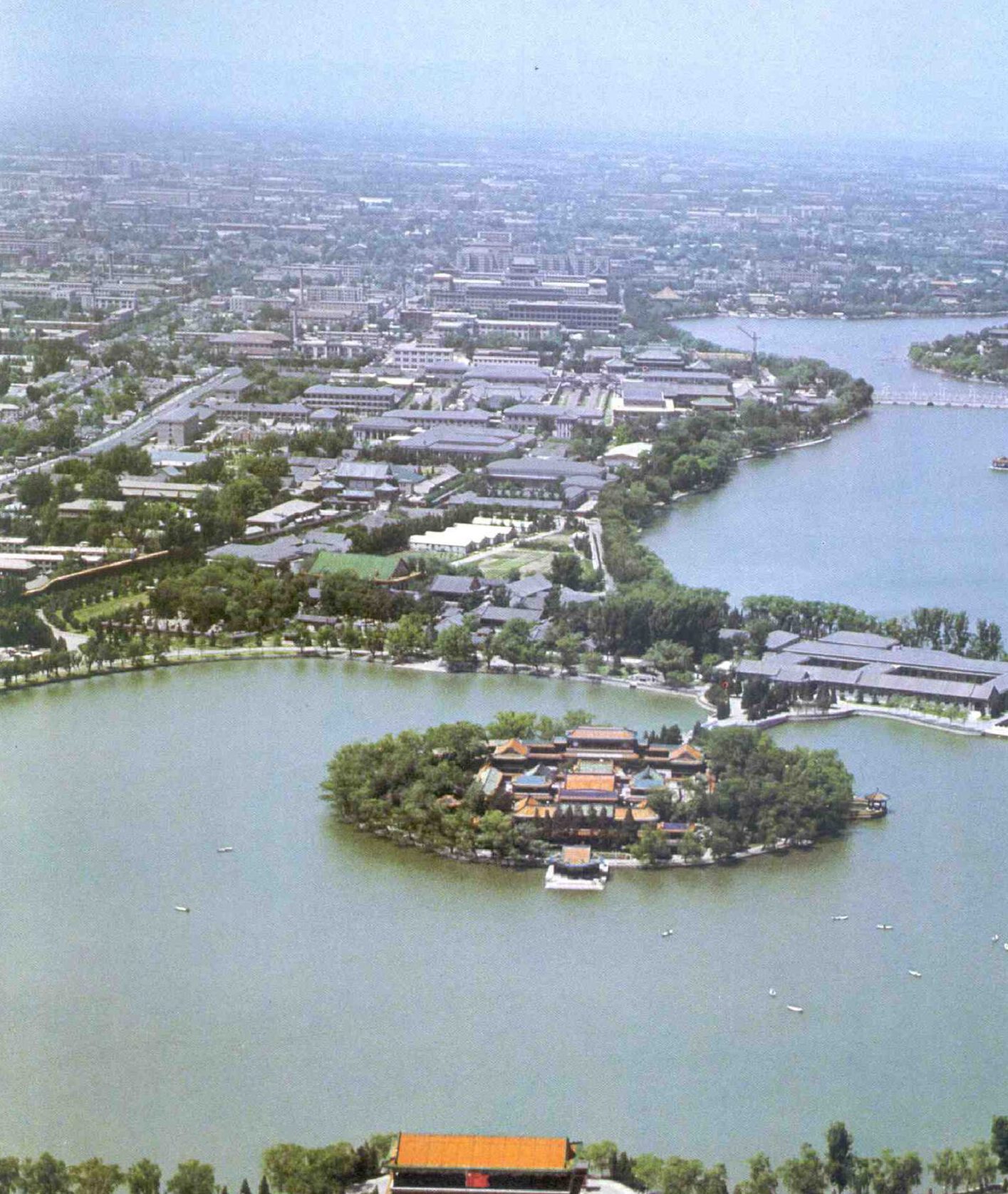
***
Under Yuan the physical reorientation of Beijing began in earnest, starting with the demolition of the walls of the imperial city 皇城. Today only a small, broken remnant of these can be seen at the Imperial City Wall Park that extends along the eastern flank of the Forbidden City from Chang’an Boulevard to Heping Boulevard in the north. Meanwhile, New China Gate 新華門, a Chinoiserie main entrance to the Lake Palaces was created for the government of the Republic. When Yuan made his imperial gambit, he declared that henceforth the Lake Palaces would be the Palace of New China 新華宮, heart of the Chinese Empire 中華帝國.
***
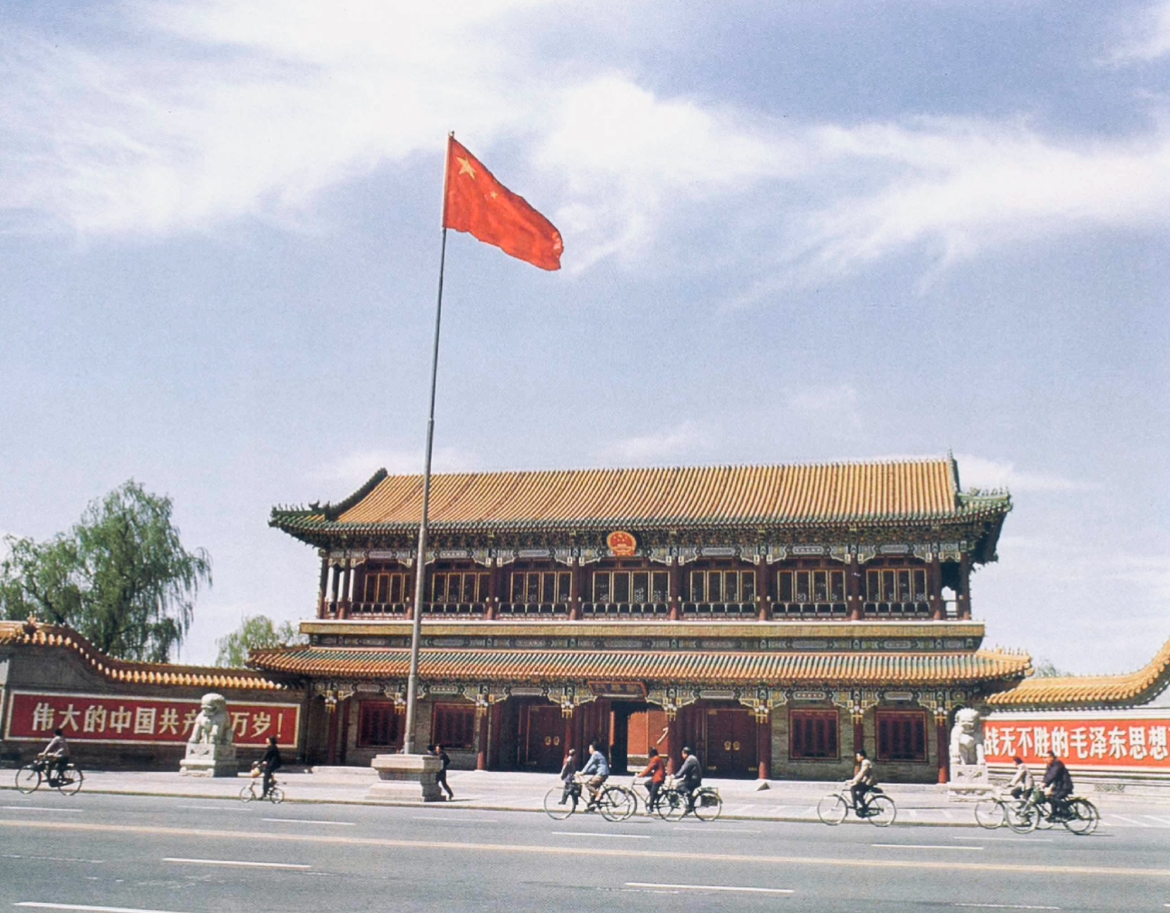
***
The lavish gate was to serve as a podium from which the military ruler could review his troops, their serried ranks marching along an east-west axis in front of it. This new axis itself was significant in that it literally turned the imperial north-south geometry of Beijing around, marking a basic realignment of the design of the city that would continue unabated for the next 70 years. The new axial route would eventually become Chang’an Boulevard, the multilane highway that cuts a swath through the centre of the modern city.
***

***
The People’s Liberation Army led by the Communist Party occupied the ancient city in 1948 and, in 1949, the Communist government declared Beijing to be the capital of the new People’s Republic of China. The architects and urban planners Liang Sicheng and Chen Zhanxiang presented to the new party leaders what they called the ‘49 Scheme’, a city plan that proposed the creation of a new municipal centre to the west of the old, walled city of Beijing. Their plan would have located the socialist government of the Communist Party in the same area where the Japanese military had established their headquarters during its occupation of the city from 1937 to 1945. Under the ‘Liang-Chen Plan’ 梁陳方案, the old city would have been preserved in its entirety, an ambulatory garden created atop on the 500-year-old city walls.
***
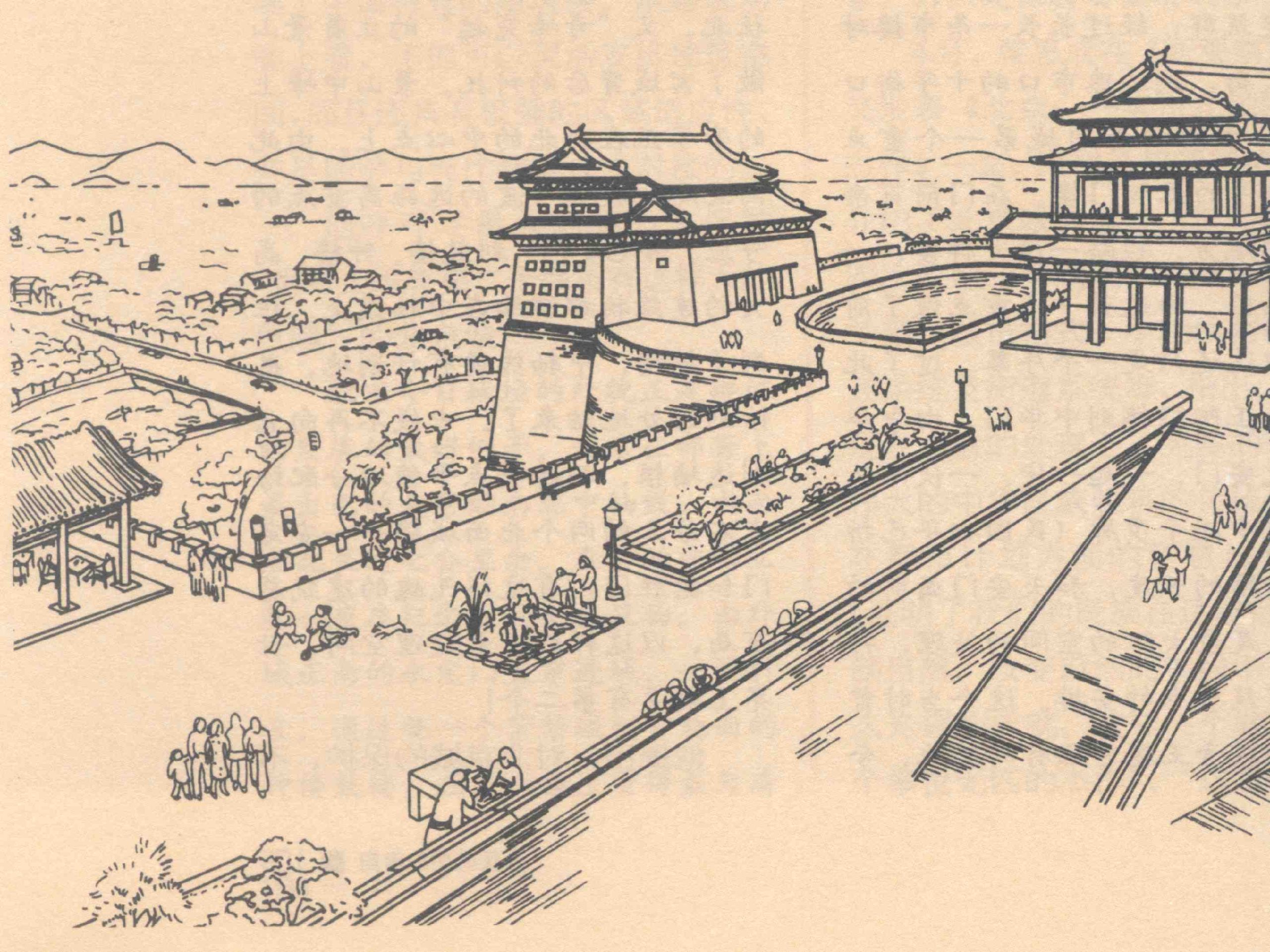
***
In 1952, the central government vetoed the Liang-Chen Plan, although arguments over the design of the capital of socialist China continued. In July 1953, Peng Zhen, the mayor of Beijing, declared that majority opinion of the leadership favoured demolishing the city walls; retaining the Forbidden City would preserve more than enough of old Beijing. Party Central and the people’s government would then be able to occupy new buildings that would be built around an enlarged Tiananmen Square. Eventually, it was hoped, the Forbidden City would be surrounded by six to eight storey high-rise offices. An avenue of equally impressive buildings would also line both arms of Chang’an Boulevard. These heroic structures of the new socialist China would thus overshadow, both literally and figuratively, the squat and disfiguring remnants of the feudal past. Anyway, despite dutiful discussions with experts, extensive consultations with the labouring masses and the consideration of the city’s cultural heritage, Peng Zhen had learned that ‘Chairman Mao doesn’t like old Beijing; he wants to see it torn down and rebuilt’. The only thing that held the government back from acting on the drastic proposals drawn up in the 1950s was a lack of money.[6]
The new rulers of the conquered city nonetheless achieved a radical re-engineering of the place: the feminized, supine, inward looking site of what they regarded as being Manchu-Qing betrayal and decadence, a city of gongzige’r 公子哥兒, kuotai 闊太, mingshi 名士 and xianggong 相公, a place of unique culture and refinement, was transformed into an heroic city of party stalwarts, workers, micro-factories, industrial plants and, above all, robust, progressive, polluting production. Paradoxically, the survival of the old city of Beijing, and the remnants of its imperial north-south orientation, was the result of the two most radical revolutionary movements, or rather calamities, of recent Chinese history.
The economic dislocation and political in-fighting resulting first from the Great Leap Forward of the late 1950s, and then from the Cultural Revolution of the 1960s, frustrated the plans that had been drawn up for the razing of substantial parts of the Forbidden City. They also put paid to the building of a mammoth Chairman’s Office designed like a Stalinist wedding cake in the centre of Tiananmen Square, and they sidelined the scheme to construct a multi-lane highway in front of Wu Men, the formal entrance to the Palace Museum. The demolition of the old city walls, and the creation of, for the moment, car-less freeways, however, continued well into the Cultural Revolution era (c.1964–78).
***
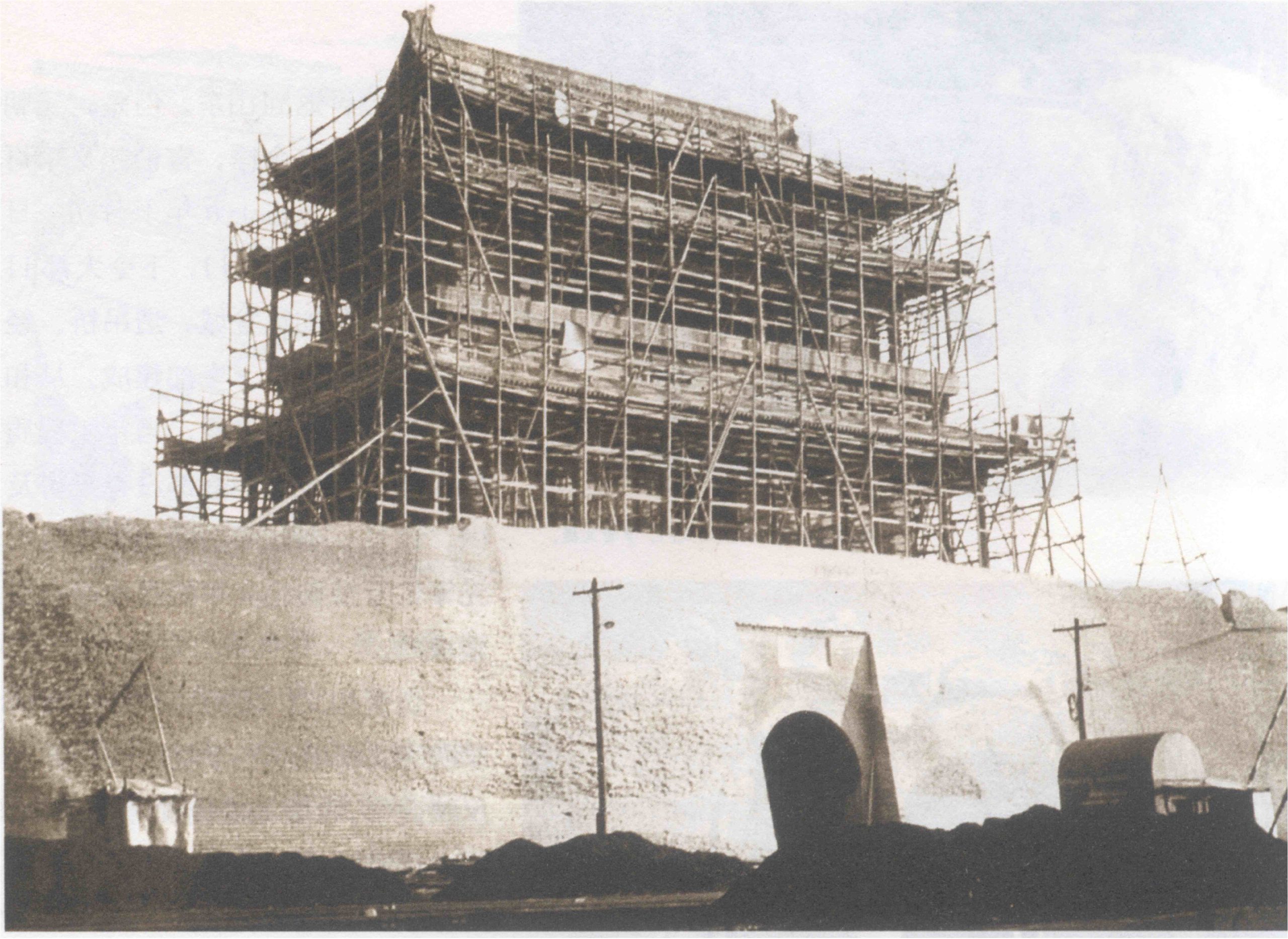
***
拆那 — China/ Chai ne
Bewailing the fate of an old Beijing that was itself merely a remnant of an older Beijing, lamenting the destructive forces of change wrought by political fiat, economic necessity or foreign influence is hardly something new in the city’s history. Following the burning of the palaces of the Garden of Perfect Brightness 圓明園 in 1860, Wang Yunkai composed a lengthy lament about the loss; the May Fourth writer Bing Xin regretted the death of Beiping, the city as lover, at the time of the Japanese invasion in the 1930s; and, in the 1970s, Simon Leys (Pierre Ryckmans) included an impassioned cri de coeur for the city in Chinese Shadows. There he said that ‘the manner in which the Maoist regime has used Peking: it has the old capital in order to give its power a foundation of prestige; in taking over this city, it has destroyed it.’ Then, in the 1980s, the Italian journalist Tiziano Terzani, guided by the historian Lo Hui-min, detailed Beijing’s ‘death by a thousand cuts’. Then, in the 1990s, the appearance of a series of plaintive essays by the Beijing-based writer Zhu Rong marked a wave of home-grown longing related to the death of ‘Old Peking’ in the form of prose, film and song.
But in many respects the history of Beijing over the past 150 years, like that of so many cities, is one of repeated demolitions and diminutions. It is a history often told in the form of multiple and multiplying regrets for things past. In the 1980s, the concrete reality of the living conditions of many people in the now increasingly sought-after courtyard houses of the old city was an indication of how little of the heavily romanticized old Beijing was then habitable. The ‘three ages’ of courtyard house occupancy hint at what lurked behind the low, grey walls of the city’s hutong 衚衕 alleyways:
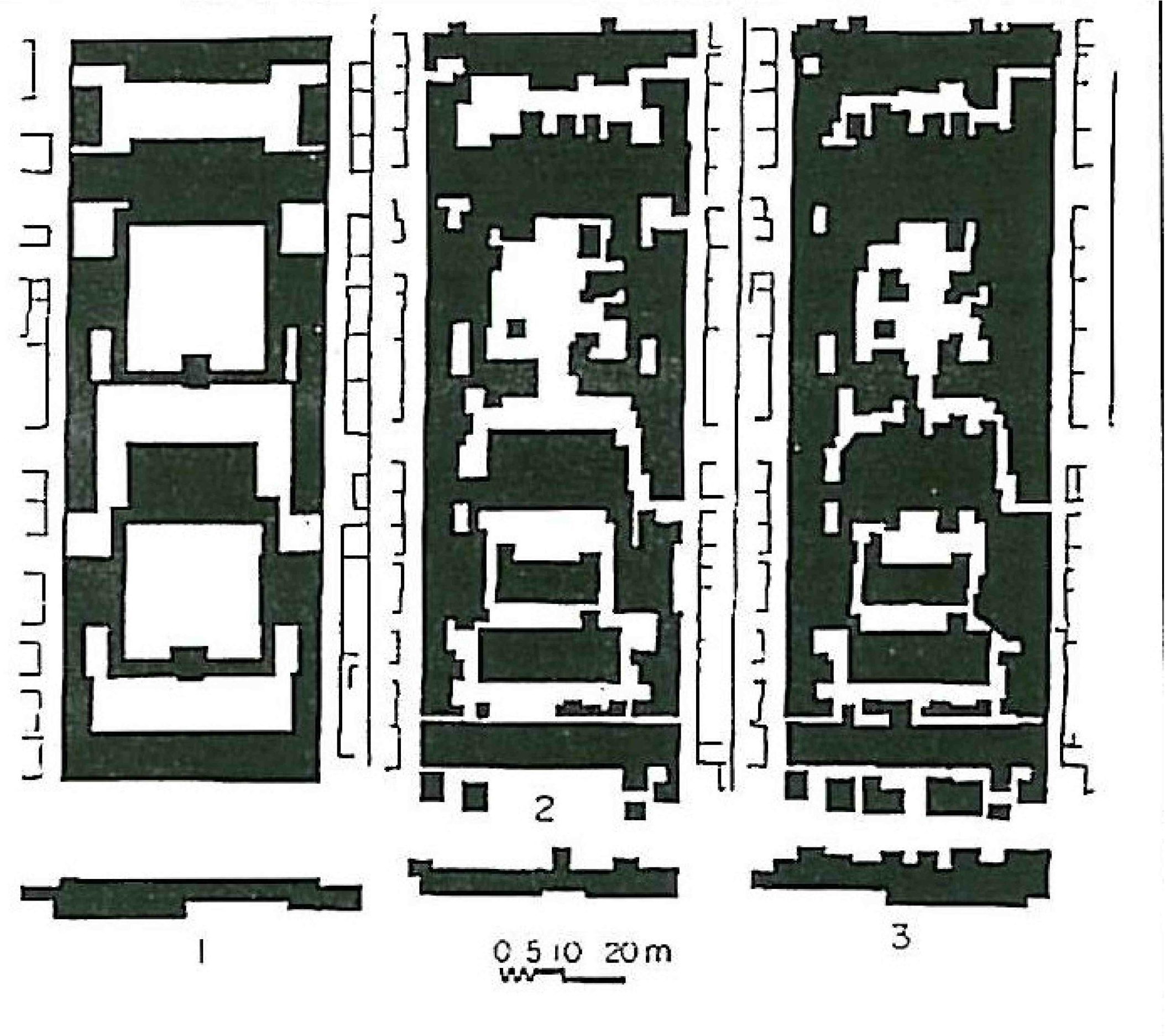
- the early 1950s: a traditional courtyard house 四合院 with some 2440.5 square metres of living space;
- the late 1970s: the ‘tenement courtyard’ 大雜院 in which there was a 131 per cent increase in living space and diminution of courtyard area; and,
- after 1987, the ‘tenement house without courtyard’ 雜兒無院 had made an appearance, boasting a living area that was 155 per cent greater than that of the original courtyard house.
While many people were anxious to escape from the courtyard slums, the comic novelist and Beijing wiseguy Wang Shuo reflected the sense of inevitability as rampant urban renewal cut swathes through the city. With typical brevity and mordant wit he asked: Why do you think they call it ‘China’? Because everything’s chai ne 拆呢 (being torn down)!
Other wags noticed the orthographic similarity between the Chinese character ‘chai’ 拆 (to demolish, or tear down) which, from the early 1990s, has been emblazoned throughout the city, marking the rows of buildings and walls up for the wreckers, and the equally ubiquitous character ‘zhe’ 折 (discount). This is a word most often featured on store windows to advertise the state of permanent (and desperate) ‘sale’ in which the urban consumer economy seems to be mired. As Peter Neville-Hadley writes in the Frommer’s Guide to Beijing:
Once the ancient buildings come down to be replaced by shiny shops, the chai character seems to reappear. But one little brush stroke is missing from the new version in shop windows—a dian 點, the smallest of all strokes, and little more than a dot. This tiny difference is enough to change the character’s sound to zhe 折, and its meaning is changed to something more constructive.[7]
***
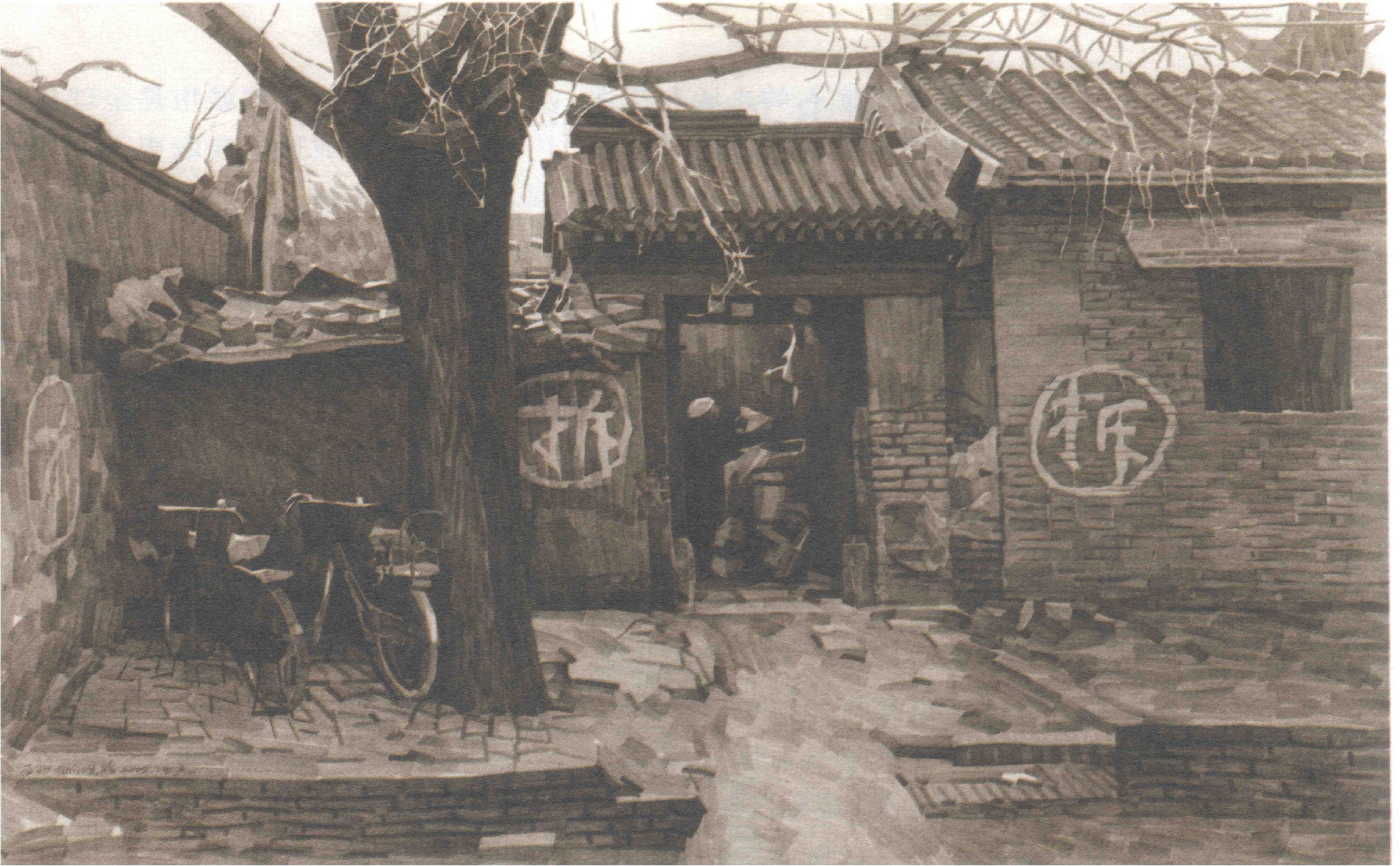
***
And so it is, these two words chai and zhe capture neatly the cycle of urban renewal in Beijing: The old is destroyed to make way for the new; the new is then discounted to be sold off cheaply. A simulacrum of the old—the retro-fitted hutong—is built in its place and then sold at a premium. The process was accelerated with the ongoing economic boom in the city, by the looming Olympics and by the heritage plans drawn up in the last decade. In 1999, 25 protected cultural and historical sites were promulgated, and work on the radical, often destructive, ‘protection’ of them has accelerated since the Olympic announcement in 2004.[8]
***
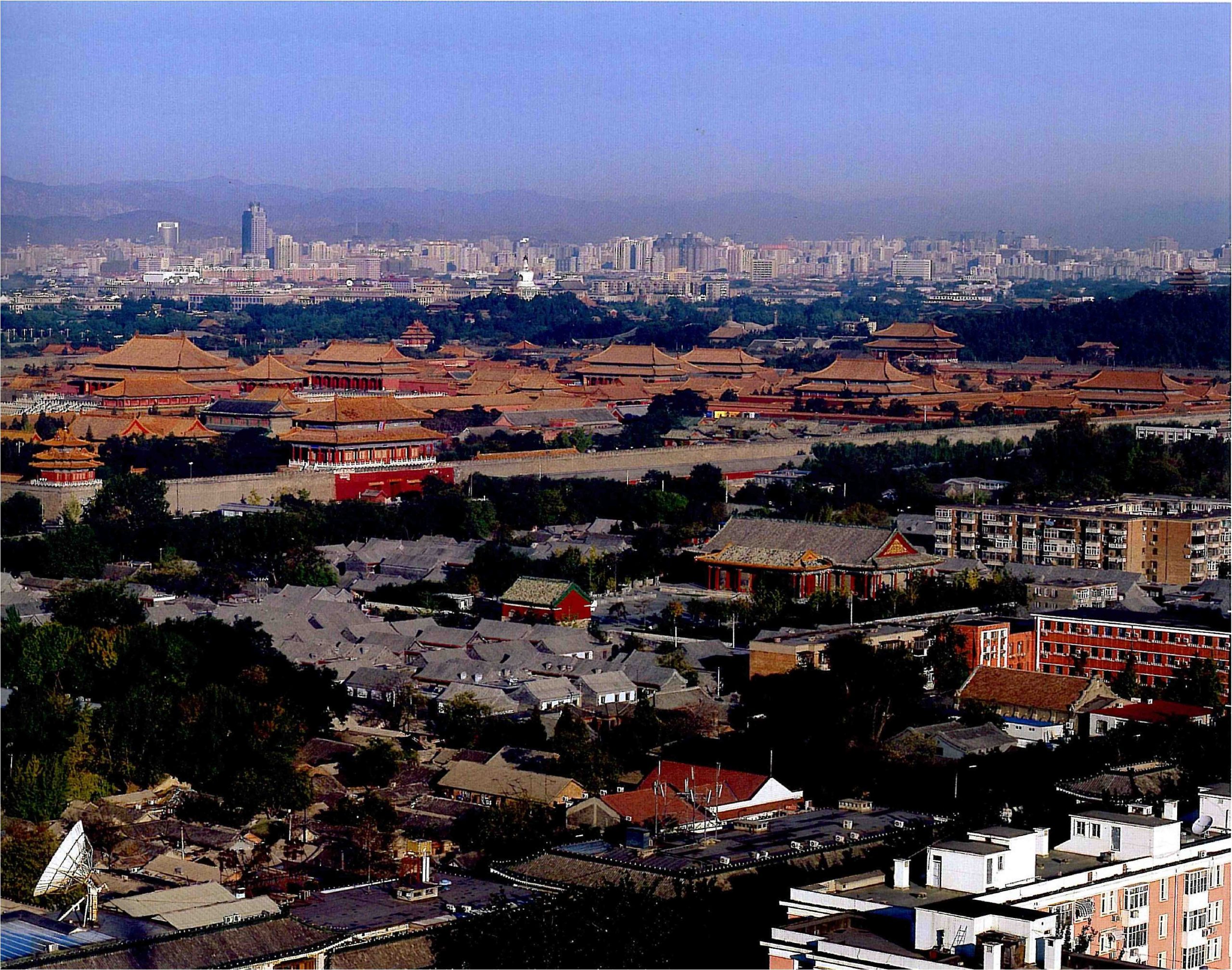
***
Some sense of how these areas are being ‘protected’, however, can be gained from considering Qian Men and Dashala, formerly the city’s most famous shopping and theatre district. Demolition of swathes of buildings in the area, except for a handful of previously listed late-Qing and Republican structures, began in earnest in late 2006. Yet the company that won the contract for this bold heritage makeover soon withdrew from the project claiming financial problems. The option for this development was then taken up by Pan Shiyi, known for the SoHo buildings at the new CBD (called Xibi di in Chinese, an expression with a particularly salacious undertone: 西屄地) at Jianguo Menwai in what was formerly the socialist-era foreigners’ district. Facing a vista of construction rubble and a schedule that demanded a new Qian Men by the time of the Olympics, work on a jerry-built Qing-themed shopping mall progressed rapidly.
***

***
This kind of ‘chai na’ is not so new. Heritage fakery was first successfully essayed in Beijing in 1980 when today’s champions of old Beijing—people like Wu Liangyong of Tsinghua University—enacted their plans for the rebuilding of Liuli Chang south of Heping Men. The book-vendors and specialists in art, seals and stone rubbings were cleared and the old Ming- and Qing-era curio shops were demolished to create a Liuli Chang tourism zone that boasted gaudy Qing façades and ample tourist parking. The ‘façodomy’ of that era was now to be visited upon the city as a whole.
***
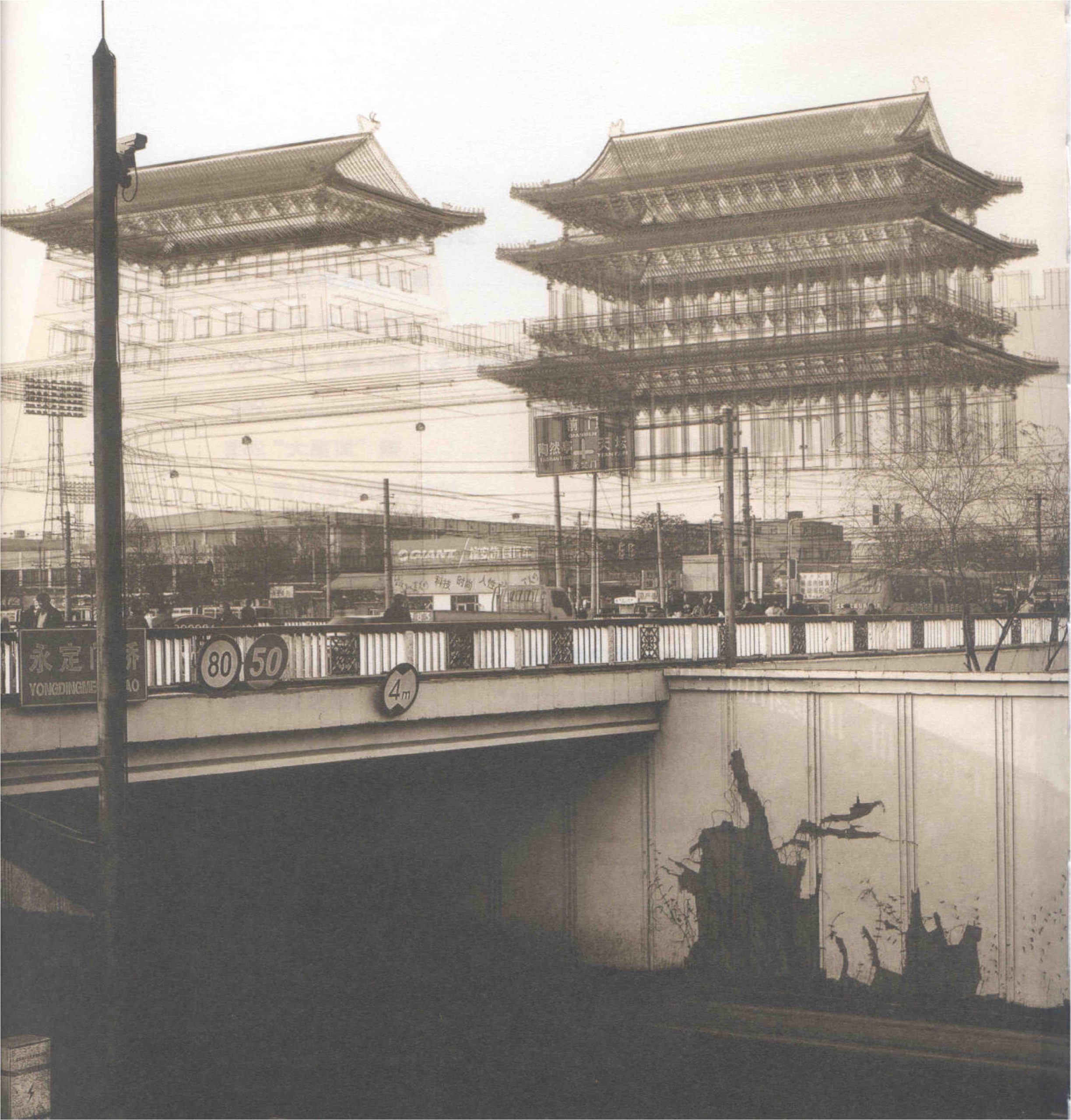
***
Others have decided that the best way to preserve the past is virtually. In the 1990s, the Beijing Crystal Digital Company created a series of images of the old city walls and gates in spectral relief over the highways and junctions that have replaced them. Old Beijing is already featured in theme places like the back lot of Beijing Film Studio, at the ‘First City Under Heaven’ 天下第一城 park at Anping county in Hebei Province and at the massive to-scale Forbidden City at Hengdian in Zhejiang. Perhaps, some day soon, the city will appear in all of its imagined glory in various virtual guises, or in night-time drone shows.
Time and Space Remade
In the new city plans drawn up since the 1990s, Beijing has experienced another orientation. Under the former Party General Secretary Jiang Zemin (1989–2003), a third axis was added to the city. Until then there were two axes: the old imperial north-south fulcrum through the Forbidden City, and the east-west Republican-era and socialist axis along Chang’an Boulevard. Although poles apart, they did intersect at Tiananmen Square. However, since 4 June 1989, Tiananmen has been a place where public celebration has frequently mixed with political caution.[9] And so a new north-south axis was created with the building of the Millennium Altar just west of the Military Museum. Paradoxically, the new axis is in the part of town where some half a century earlier Liang Sicheng had advocated the construction of a government centre for new Beijing.
***
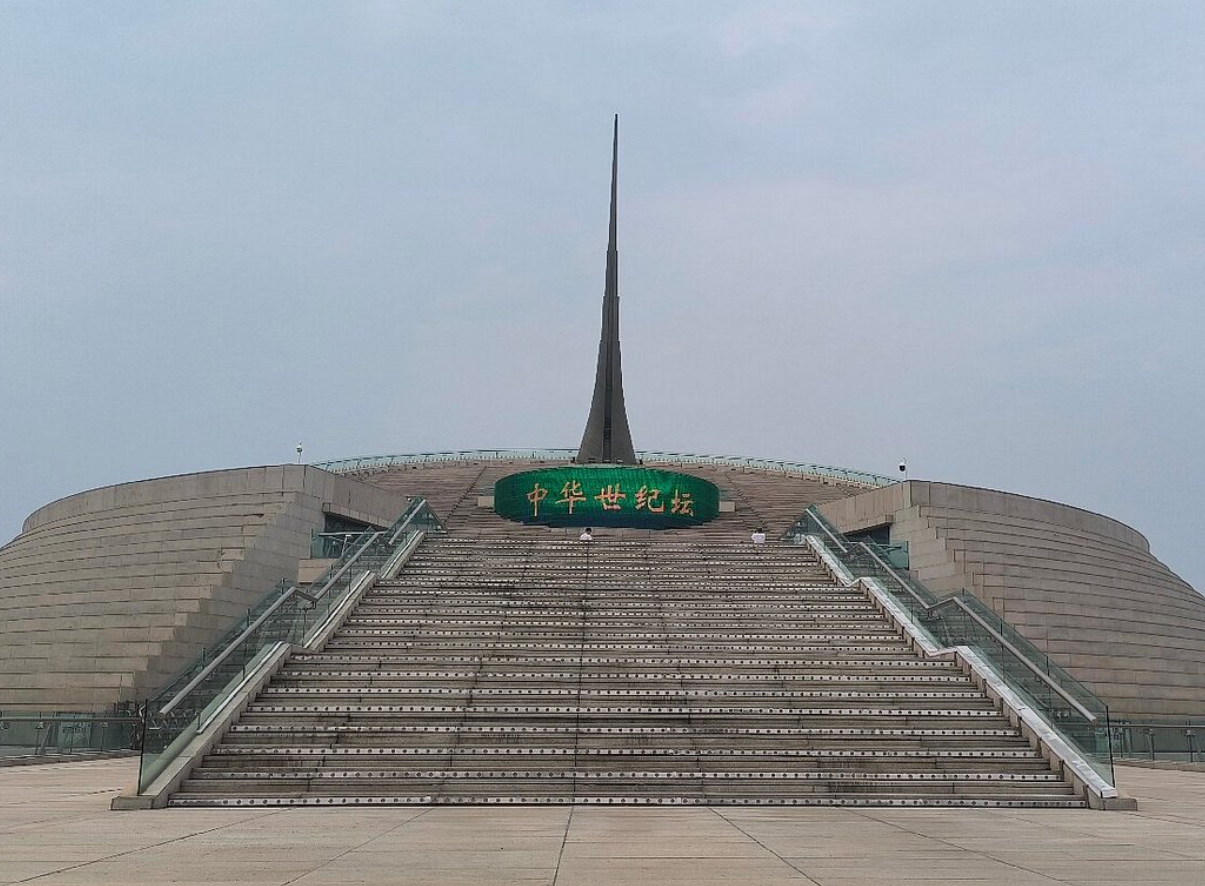
***
Of all the altars in Beijing—and there are many: the Altar of the Earth and Grains 社稷壇, as well as altars to the sun, moon, earth and heaven 日壇、月壇、地壇、天壇—the Millennium Altar 世紀壇, is the only one that does not lie flat open to nature and to the elements. Instead, it is built with a trajectory all of its own. To mark its imaginary, forward-moving ‘momentum’, a pinnacle, a shooting lance or launching pad has been installed. The Millennium Altar is also a concrete version of the old marble sundials, or rigui 日晷, found outside the main audience halls of the Forbidden City. The rigui symbolized the unified time of the empire (one of these featured in the opening moments of the Beijing Olympic Opening Ceremony on 8 August 2008). The new north-south axis leads from the Millennium Altar to the Beijing West Train Station, which is itself topped by a faux-imperial gate. This latest reorientation of the city—where celebrations for both the new millennium and the official party for the Olympic announcement in 2001 were held—means Beijing now has two north-south axes and one major east-west corridor or, as the urban planners refer to it, ‘the two axes and one line’ 兩中軸一線.
Creating iconic new city centres with stratospheric symbolism is not something particularly new in China. During an earlier moment of national renewal under the government of the Republic of China in the 1930s, ambitious plans were drawn up for many cities, in particular for the Nationalist capital of Nanjing, as well as for the mercantile centre of Shanghai where the authorities decided to build an alternate, entirely Chinese centre for civic administration at Yangpu. This ‘Great Shanghai’, as it was dubbed, was to be constructed to the northeast of the foreign-controlled concessions of the city proper, far from alien influence and control.
***

***
The main design for the new Central District of Great Shanghai was devised by a team working under Doon Dayu (董大酉, 1899–1973), a graduate of Columbia University. Seen from above, the new city would appear to be a place anxious to be airborne itself. Its main functional structures featured a marriage of modern western building techniques with the Chinese-style roofs or ‘big hats’ 大帽子 favoured in the early Republic (and then again under Beijing Mayor Chen Xitong in the early 1990s). Other fabrications were fanciful, ambitious follies. One in particular, a building designed for the Aviation Association of China, combined the celestial symbolism of Beijing’s Temple of Heaven with the modern obsession with air travel.
***
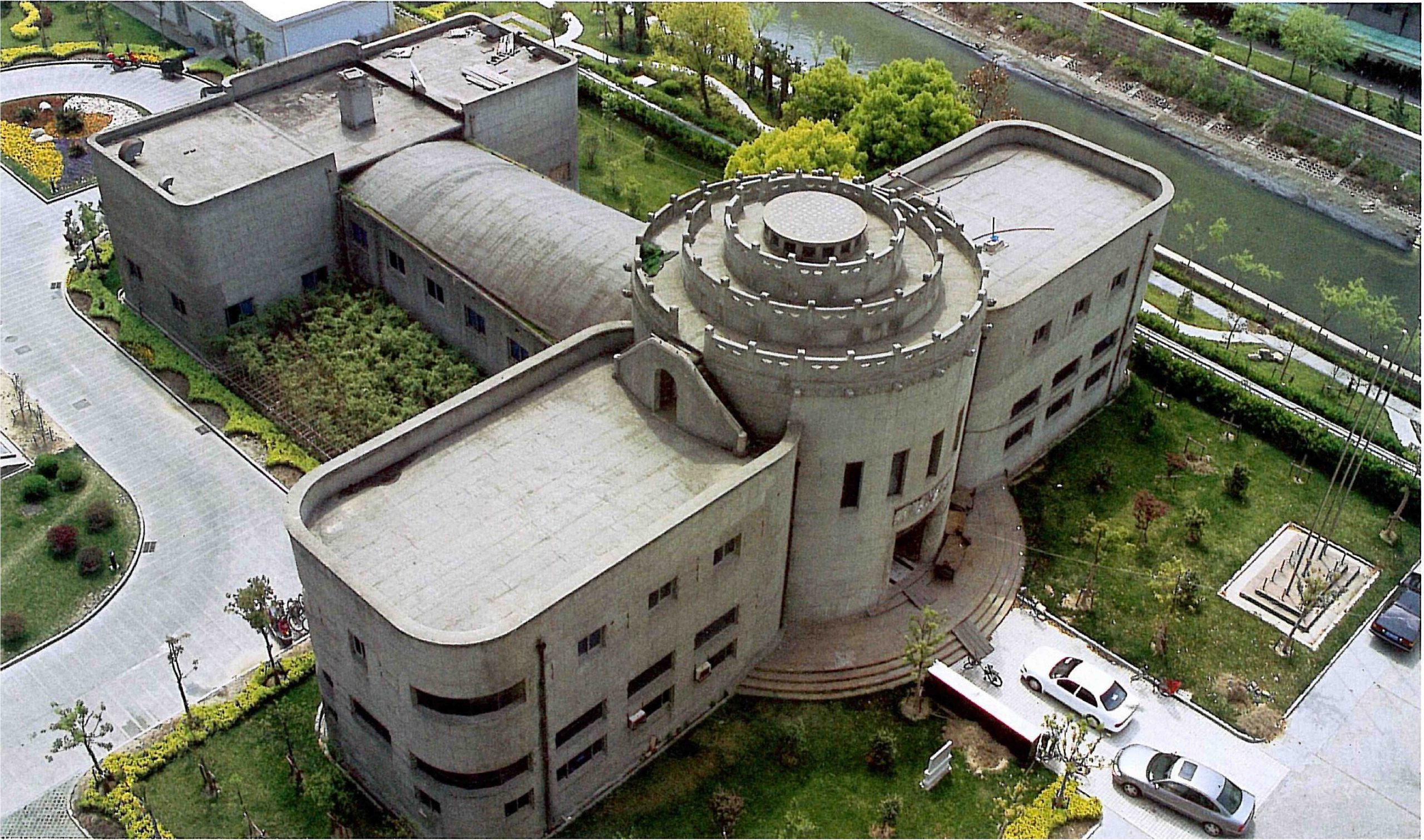
***
Making a Spectacle of the Olympics
We have all been witness to the international media frisson resulting from the relaunching of Beijing itself in recent years. That city is now a celebrated metropole of the East; its veiled politics and conflicting histories are nothing compared to the hype-driven commercial possibilities of a rising China.
Beijing is also witness to the stand-alone office monument, the edifice as advertisement. The signature structures of recent hyper-development, however, distract from the vast new gated communities, the battery housing estates and the faceless sprawl of post-rural conurbation. While these places and their own communities tell complex stories about the modern Chinese city and its inhabitants, it is the new monuments of socialist state capitalism that mark Beijing’s latest orientation.
***

***
On Chang’an Boulevard, next to the 1950s Great Hall of the People, is Paul Andreu’s National Centre for the Performing Arts, or the ‘great stinking egg shell’ 大臭蛋殼兒 as some call it. The Harvard University-based Rem Koolhaas, the celebrated CultStuds architect of displacement, is also a creative collaborator in the Beijing brand. Koolhaas disavows traditional academic architecture, and problematises it through his theoretical pontifications. Yet he shows how playful the take of the po-mo architectural artist can be by having accepted, for example, a commission from Prada. More pertinent to my observations, however, is his design with Ole Scheeren for the new headquarters of Chinese Central TV at Jianguo Menwai.
OMA’s Koolhaas & Co. have worked in China for many years. They are known for a totalizing view that regards the only human activity left to us as being shopping and consumption. Koolhaas himself has written of the contemporary city reality in terms of ‘junkspace’—an environment that is ‘constantly new, beginning to rot, always politely under construction’.[10] Ironically, it is supposed to be a space that is non-monumental, vast and urban, a space that encompasses the entire built realm and its scissures. One is supposed to appreciate the piquancy of Koolhaas’ work designed for the ‘throat and tongue’ 喉舌 of the Party. After all, the Communist Party is a political force that constantly extols the fact that it rules over a territory under permanent construction. Koolhaus’s angular CCTV pretzel creates a teetering tower that defies itself.
***

***
Forgotten in the recent built ebullience, however, is the history of the spectacles of Beijing, stories in which power and politics lurk behind the built, as well as the bought. Some Beijing residents have voiced their disgust at the makeover of their city and what they see as the blight of architectural monuments that delineate its landscape. Jealous of the wealthy and powerful of the new age, but wary of the Communist leaders and their neoliberal economic policies, they blame the disfigurement of their city on what they call the ‘traitors’ 漢奸 in power. One Beijing taxi driver interviewed recently by the oral historian Sang Ye expressed his proletarian contempt for the international metropolis of Beijing:
With all their re-planning, Beijing has become nothing less than a bird [鳥, a Beijing dialect word that also means ‘crap’ or ‘damned’]. That off-kilter pair of legs they built for CCTV on the East Third Ring Road is how it walks. Its head is over in the west, the damn gaping maw of the Millennium Monument. Of course, a bird needs a nest, doesn’t it? Well, the nest has been plonked down on the North Fourth Ring Road [the National Stadium, or ‘Bird’s Nest’]. On the radio they even boast that it’s the biggest in the world. Fuck me dead! What the hell is so impressive about piling some disused steel beams up like that?
Of course, a bird needs more than a nest. You have to feed it something. So they built it a birdbath, you know, the thing they call the ‘Water Cube’ [the National Aquatics Centre]. And, already the bird’s laid an egg, right there on Chang’an Boulevard in Central Beijing. Yeah, the bastard’s laid that titanium blob they call the National Centre for the Performing Arts. It’s for the birds, and they’re all built by a pack of traitors… On the radio I heard that the foreign devil who designed the egg claimed he wanted to cut China off from its traditional culture so that it could be able to create new things…. Take a look at the Olympic Mascots: creatures designed by traitors to encourage mindless compliance… .
If these bastards really could turn Beijing into a bird, one that could take off and fly, one that travelled the world taking whatever it wanted, I wouldn’t be complaining. Just look at the Americans: they have an eagle on their national emblem. But these bastards of Beijing don’t have the guts, or the ability.[11]
In April 2006, it was announced that Zhang Yimou, the internationally popular Chinese film director, would lead the group designing the opening and closing ceremonies of the 2008 Beijing Summer Olympics. By then, Zhang had quite a portfolio of extravagant screen and stage triumphs to his name. One that is particularly relevant here is the 1998 Beijing production of Puccini’s opera Turandot, which he designed. It was staged in the once-sacred courtyard of the Ancestral Temple 太廟, the symbolic graveyard in the heart of the imperial city.
***
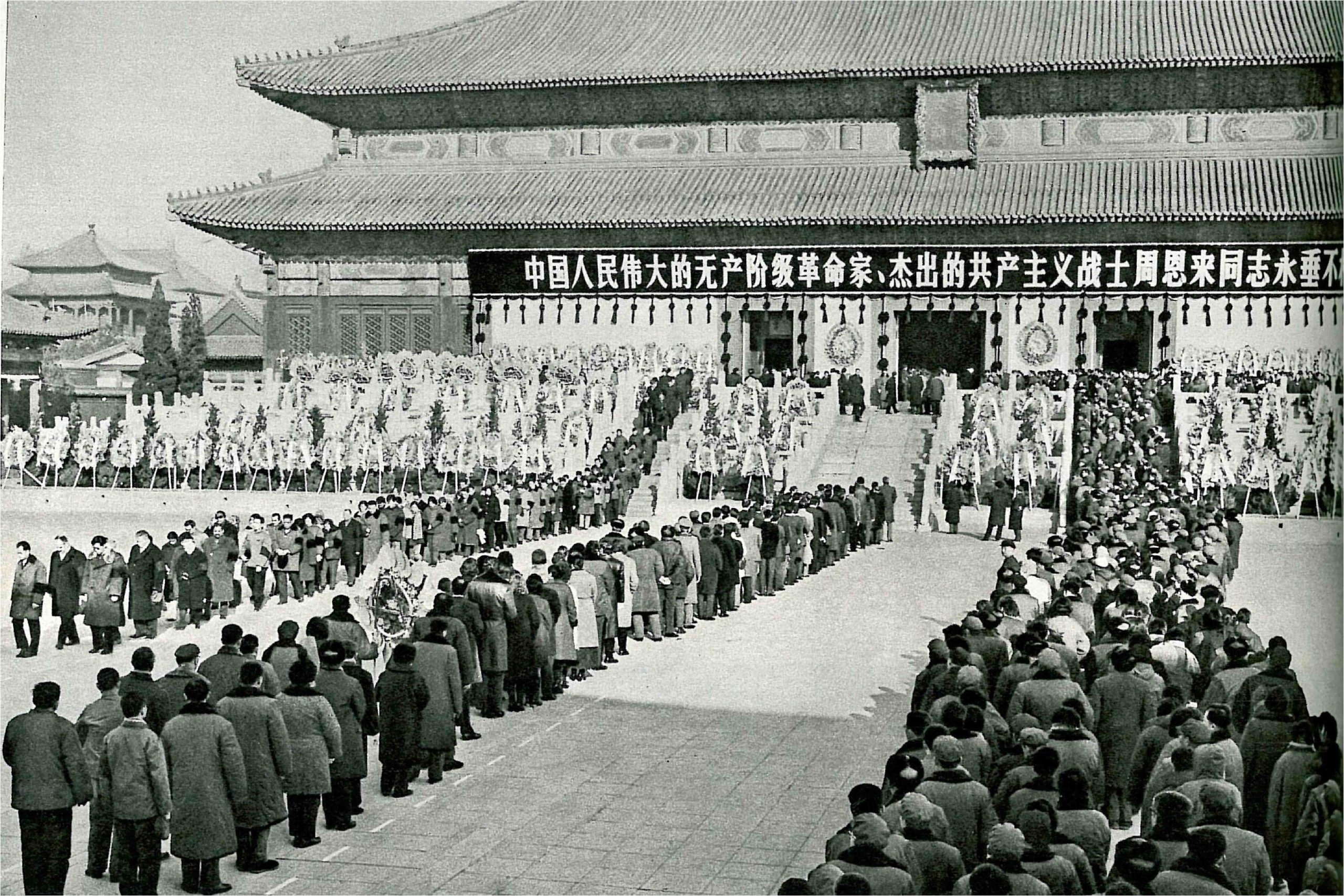
***
Apart from the occasional avant-garde art show, the main temple at Tai Miao has seen little action since its last official role in January 1976, when it was used for the official viewing of the body of the deceased premier Zhou Enlai. Zhang Yimou’s production of Turandot was grandiose, a confection that was totally in keeping with the brash and mass style of contemporary Chinese culture. Over the years other artists elsewhere have designed Turandot sets. Here I recall only one of their number: Adolf Hitler.
During his early years as a struggling artist, Hitler had an oriental vision of his own. It was a stage design for Turandot. Although the opera was never produced according to Hitler’s design, the Führer did collaborate on a far more exaggerated show on the German national stage: the 1936 Berlin Olympics. The set for that extravaganza was designed by Hitler’s architect of choice, Albert Speer.
***
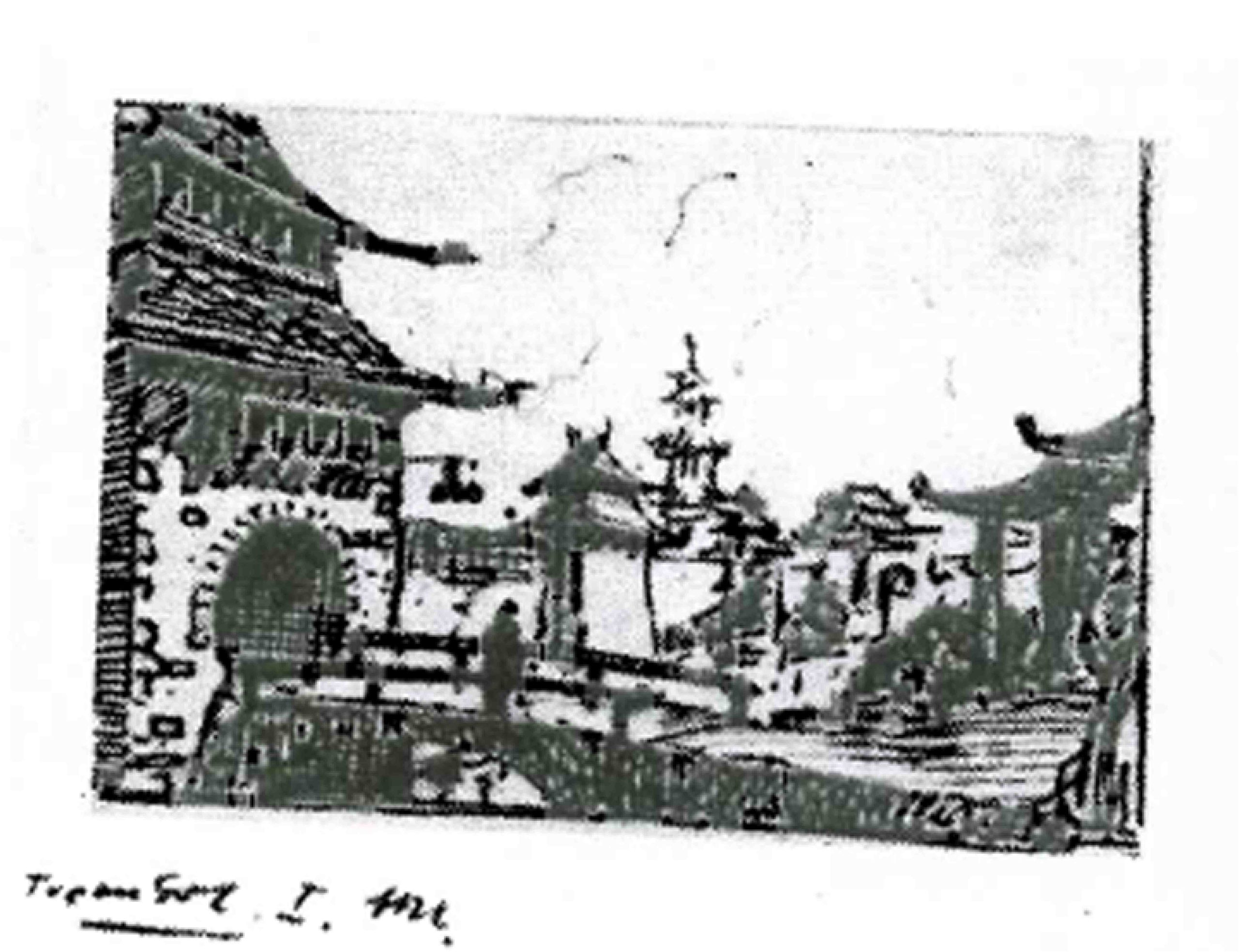
***
Although one Chinese athlete competed in the 1932 Los Angeles Olympic Games—Liu Changchun, described in the official Games’ report as ‘the lone representative of four hundred million people’[12]—the 1936 Berlin Olympics was the first of the modern games to which the Republic of China made a major commitment. The Chinese national team consisted of 69 athletes, along with 39 observers and 150 journalists. They also travelled with nine practitioners of martial arts, who put on displays of their talents. However, a games during which race was such a contentious issue was a disaster for China. As the geopolitical historian Zhang Junjun remarked, ‘our delegation presented the world with what can only be described as “total annihilation”’.[13] In a book inspired by the episode, Zhang blamed the outcome on the inferior quality 素質 of the Chinese nation, its racial weakness and the lack of northern martial spirit. For its part, the Chinese delegation wrote in its report on their ignominious results that, ‘We were ridiculed for having brought back nothing but a duck’s egg 鴨蛋’ [emphasis in original].[14]
Hitler and Speer would go on from the Berlin Olympic spectacle to devise ever-grander plans for Berlin. Together they created a monumental design for a refashioned city to be called Germania, the new capital of what they presumed would be a victorious German Reich. While the Second World War left Berlin in ruins and the plans for Germania unrealized, Albert Speer’s son, Speer Jnr, would over half a century later propose his own grand scheme to China’s urban planners. Journalists would mock it as Speer’s plan for a ‘Super Beijing’. And today, in the revived central axis of the Chinese capital, which stretches from a rebuilt Yongding Men in the south of the city to the dragon lake of the Olympic park far to the north, perhaps some would detect vestiges of the Speer-family vision.[15]
Susan Bronwell, a US scholar who has written on the history of Chinese sport, points to a moment earlier than the 1936 Berlin Olympics when discussing comparisons with the 2008 Beijing Olympics. She sees a particular connection between the US and China through Olympic Games, and significantly identifies the 1904 St. Louis Olympic Games as a key moment.
The third modern Olympic Games were held in St. Louis in 1904 alongside the Louisiana Purchase Exposition (world’s fair), and while China did not take part in the sports (it would send its first Olympic athlete to the 1932 Los Angeles Games), the Qing dynasty sent the first official delegation that it had ever sent to an international exposition… The 1904 Olympics were apparently the first Olympics to be reported in the press back in China.
The world’s fair was America’s coming-out party as a world power. It had just acquired the former Spanish colonies of the Philippines, Puerto Rico, and Guam as a result of the Spanish-American war in 1898. At the fair, it presented itself as an expanding power, with an extremely large display devoted to the Philippines. Another large section of the exposition grounds was devoted to displays intended to demonstrate that the government was succeeding in civilizing American Indians.
Bronwell describes how the European powers were unimpressed by many elements of the US games. The International Olympic Committee President Pierre de Coubertin, for instance, declared that awarding the Games to St. Louis had been a ‘misfortune’. Moreover, the scene Anthropology Days, ‘in which natives who had been brought to the fair for the ethnic displays competed in some track and field events and pole-climbing’ were ‘embarrassing’.
In talking of the 2008 Beijing Games, Chinese commentators have often pointed out that calls were made in China for that country to host a future Games exactly a century ago. C.H. Robertson, the director of the Tianjin YMCA observed:
Since 1907 a campaign had been carried on to inspire patriotism in China by asking three questions:
- When will China be able to send a winning athlete to the Olympic contests?
- When will China be able to send a winning team to the Olympic contests?
- When will China be able to invite all the world to come to Peking [Beijing] for an International Olympic contest, alternating with those at Athens?
Bronwell also offers a rather benign comparison between the 1904 US games and the 2008 Chinese games:
As the U.S. did over a century ago, China will try to display the success of its civilizing mission among its frontier minorities. It will try to display its wealth through monumental architecture and exhibitions of economic wares. In 1904, train stations were one of the major ways of displaying wealth – the St. Louis Union Station completed in 1902 was one of the largest and most opulent train stations in the world. In 2008, sports stadiums have replaced train stations, and China will have its Bird’s Nest Stadium. The St. Louis world’s fair was the biggest of all time, just as the Beijing Games may well be the biggest Olympics of all time. When a superpower holds a coming-out party, it is a hard act to follow.[16]
China’s ‘coming-out party’ (to use the tired cliché of the international media) has, however, been increasingly fraught. In the enterprise of designing the opening and closing ceremonies of the 2008 Beijing Olympics, Zhang Yimou was for a while joined by a consortium of non-Chinese ‘imagineers’. All of them have created successful public entertainments in recent years. While some of their number, like Stephen Spielberg, have pulled out due to a certain stench surrounding China’s policies in Africa, there is little doubt that Hollywood continued to be Beijing’s greatest inspiration. Indeed, China and its Communist Party rulers have been enmeshed with Hollywood and its culture of spectacle for decades. Anyone who has seen the 1964 Maoist song and dance extravaganza The East is Red 東方紅, for example, will have guessed that communist choreographers had carefully studied the best the West could offer.
***

***
It is also timely to recall that, 50 years ago, Tiananmen Square was purpose built for grandiose (and, given the ugly politics of the day, chilling) displays of upwards of a million participants. A recent example of such self-congratulatory socialist pageantry was the big parade of 1 October 1999 that marked the fiftieth anniversary of the People’s Republic. Every province and interest group had a float and a troupe of marchers in the show.
***

***
In 2005, a scaled-down celebration was held in Lhasa to mark the fortieth anniversary of the imposed Tibetan Autonomous Region. The new Potala Square in which the parade was held features a lugubrious ‘Peaceful Liberation Plinth’, lakes festooned with swirling swastikas, and a parade ground embedded with sunken fountains and lights that, when they leap to life, spray and shimmer in time to party (Communist Party, that is) show tunes. It is little wonder that local artists I met when travelling there called the once holy city Lasa Weijiasi 拉薩維加斯: Lhasa-Vegas. It is a playful appellation that perhaps few in Tibetan China would find appealing following the murderous events of March-April 2008.[17]
***
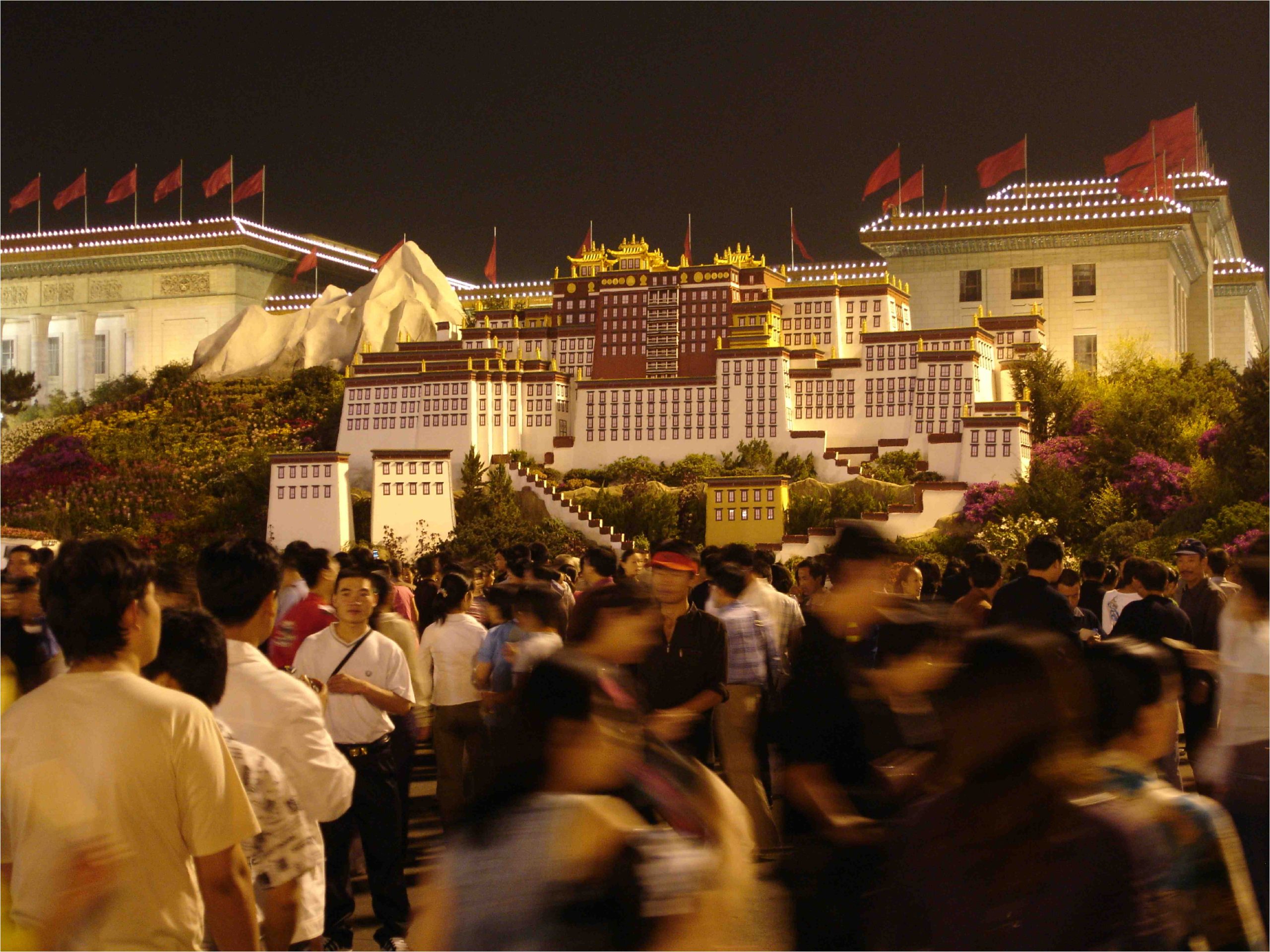
***
Despite mass demonstrations, the debacle of the Olympic Torch Relay internationally, and the extreme security measures imposed on Beijing, the 2008 Olympics will provide a unique opportunity for China to show the world a vision of itself, and what it has to offer as a nascent global power.
There is no doubt that the ‘imagineers’, both Chinese and foreign, who have contributed to the Opening Ceremony of 8 August 2008, will wend a sprightly way through a lot of history and culture that is pretty much unpalatable. Those once-hallowed ancient customs of concubinage, foot binding for young girls, and the castration of boys being sent into imperial service lack a modern feel-good factor, but inevitably there will be a phalanx or two of entombed warriors from the Qin dynasty.
Zhang Yimou has already declared he is determined to showcase recherché elements of regional culture in his show. So inevitably, once-subjugated peoples—those who some Han Chinese derisively call the ‘singing and dancing minorities’—that is Mongols, Tibetans, Uyghurs, Dai, Zhuang, to name but a few, will be prevailed upon to add exotic colour, and a sense of rhythm, to the proceedings.[18]
Lift-off
And so it is that Beijing has been reoriented, physically as well as ideologically, a number of times since the late Qing dynasty. From a city in its refined, impoverished imperial twilight, a city of consumption, and for some, of decadence, it would become a centre of production, not only for factory goods, but also for the manufacture and exhibition of the state symbols of a new China. In the process city was, quite literally, turned on its axis. Since then, local enterprise and international business have combined by one-party power to create a much-altered urban landscape.
***

***
Today, once more Beijing is a city of consumption; it is also the symbolic centre of the latest version of the Chinese new order, one in which global capital and a heavily policed harmonious society prevail. Given this radical public make-over, it is all too easy to forget the other reorientations that have taken place in Beijing and by extension in China in recent years.
In considering Beijing’s reorientations, we could consider, too, the century-long debate about geography, race and the national character that has seen north pitted against south, and Beijing in repeated contestation with Shanghai. In this context I would also mention other new orientations, such as the one whereby the developed east of China is contrasted with the backward west, or that in which suzhi or quality is about place, people, behaviour and class. I would speak of the work of Andre Gunder Frank and the analysis of China Studies in the West by Wang Hui. I would consider the major new state project to produce a National History of the Qing dynasty; I would talk, too, of how the vocabulary and ideas of China’s ‘new left’ thinkers work their way into mainstream discourse as a kind of academically re-branded Marxism-Leninism, as well as the tireless attempts by displaced intellectuals to return to the centre stage of national life by promoting New Confucianism. And, in the context of 2008, I would discuss hypernationalism and what have been called China’s ‘online Red Guards’.[19]
In the exuberance of consumerism, the jouissance of product placement and the architectural makeover of the nation’s cities, it is easy to turn a blind eye to the masking of historical ruptures and unsettling anniversaries. I will mention again the fact that 2008 marks 110 years since the fateful months of the Hundred Day Reform attempts to modernize the Chinese empire. It is also the centenary of the passing both of the Empress Dowager Cixi and the emperor Guangxu, who initiated the reforms I touched on in my opening comments.
More importantly, for students of contemporary China, it is 30 years since the Third Plenum of the Communist Party’s Eighth Party Congress, a momentous meeting in Beijing that formally launched the country on its present course of the ‘open door and reform’. In the shadow of that congress—and of the celebrations already marking it—lurks the spectre of the Beijing Spring and the Democracy Wall at Xidan 西單民主牆. That was a place where popular will found expression through posters expressing grievance and hope, as well as some calling for greater rights and freedoms. The most famous, and still resonant, of these was Wei Jingsheng’s call for a Fifth Modernization, a modernization of China’s political life and the introduction of democracy. There will be no official celebration of the 30th anniversary of the Beijing Spring in 2008.
***
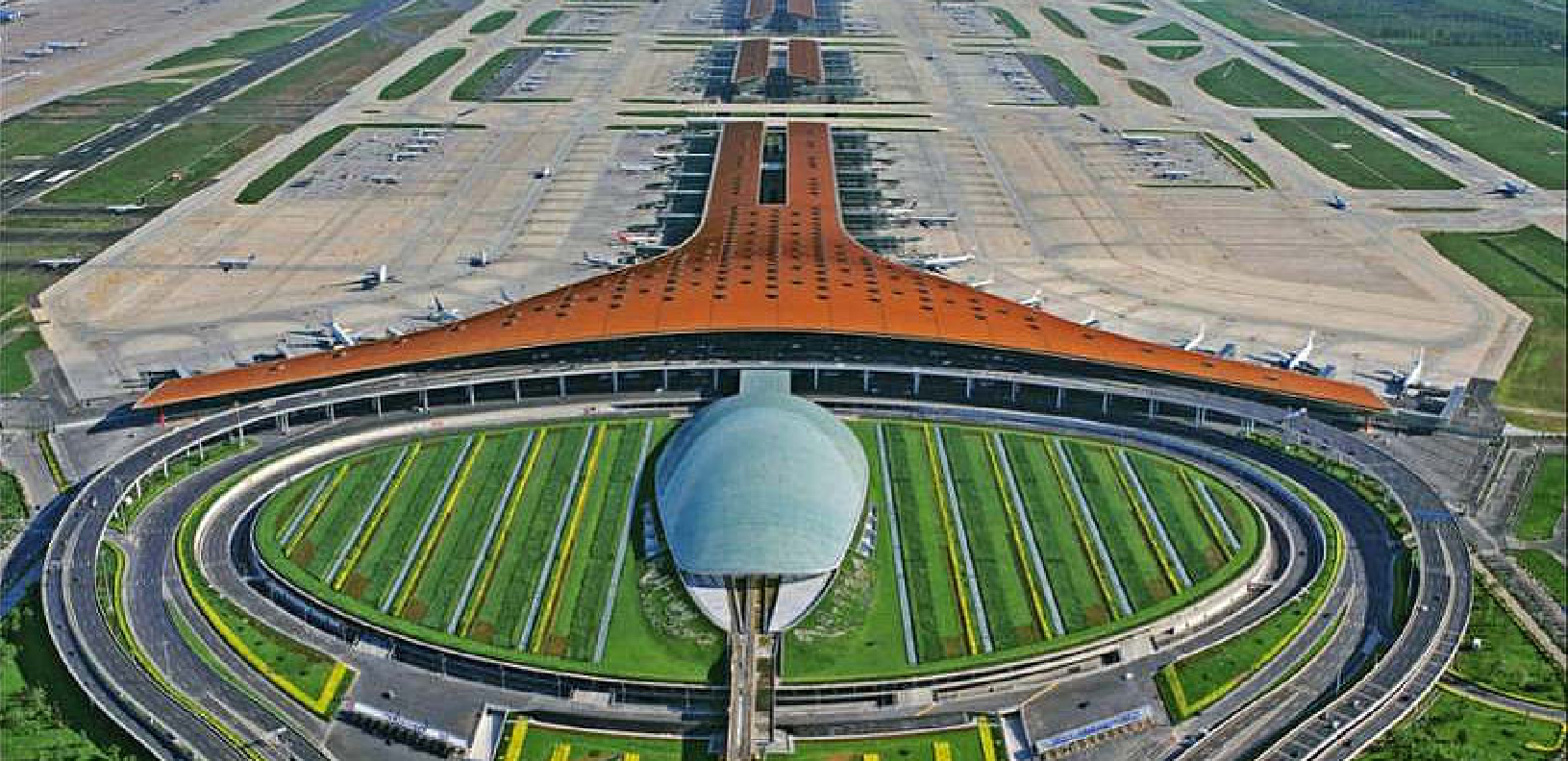
***
In conclusion, allow me to return to the departure point for my discussion: the dragon that once lurked under Beijing. Today, apart from the Dragon Lake of the Olympic Village, yet another dragon-shaped icon has taken shape in the northeast of the city. The splayed form of Beijing Capital International Airport Terminal 3, designed by the British architectural firm Norman Foster + Partners, actually houses the fourth airport that has serviced the Chinese capital in four decades.
While this latest dragon of Beijing is in constant terrestrial flight, it has opened in time for the 2008 Beijing Olympics, which have seen the depleted water resources of the city become a point of contention once more. The Olympics, like the greedy dragon that the boy-god Nezha was said to have quelled, feed off the limited water resources of the city. According to specialists on Beijing’s water, the Games are feeding off the dwindling subterranean reservoirs of a city that has been long benighted by drought.[20] Nor should we forget the fact that Beijing today remains, after all, the capital of a regnant Communist Party. It is a city that is the careful creation of revolutionary destruction, and constant reconstruction. Its contemporary re-orientation also reflects the imperial ambition of the country’s post-revolutionary rulers.
***
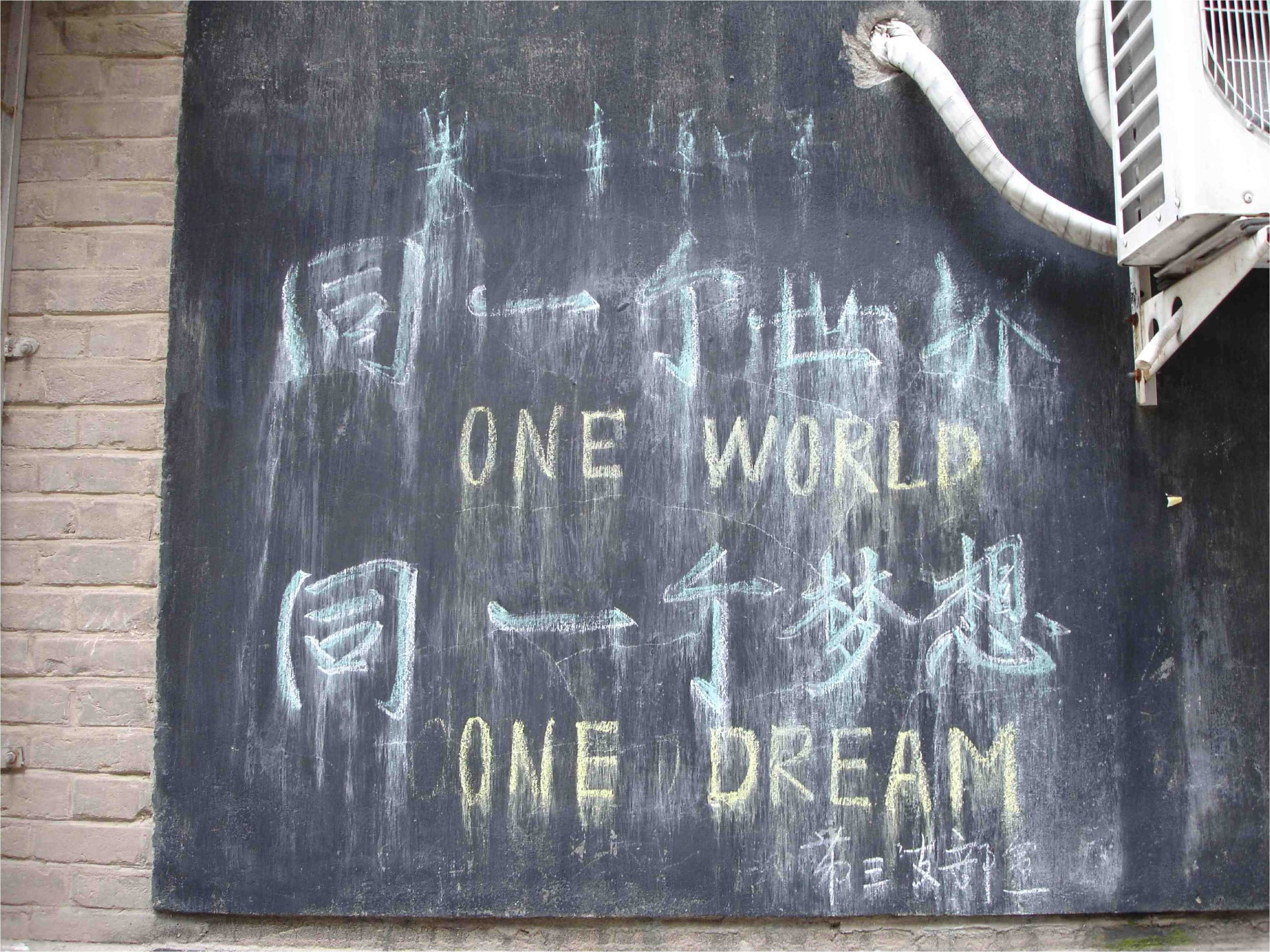
***
The slogan for the 2008 Beijing Olympics, ‘One World, One Dream’ echoes the utopian promise of the socialist past, of a world united. However, when considering this vaunted hope for unity today we should be mindful of the fact that the Olympic slogan imagines a shared amity, but one that can be achieved only if we are willing first to go to sleep. World consensus on the basis of a shared vision is a chimera that to this day enjoys a physical purchase in the heart of Beijing. It can be seen in the large socialist-era slogan that continues to festoon Tiananmen Gate: ‘Long live the great unity of the peoples of the world!’
Slogans decorate the gate, and they bracket the looming portrait of Mao Zedong that hangs over the central portal to the Forbidden City. Mao’s legacy, too, is not far away. He was the man who, following the ‘peaceful liberation’ of Beiping in 1948,[21] declared war on a city that represented the feudal past, a war from the ruins of which the Beijing of New China would emerge. It is a process that continues to this day.
***

***
A New Beijing — the Xiong’an New Area
Xu Zhiyong
The Wrong Time:
Take the Xiong’an New Area 雄安新區, announced [in 2017] with great fanfare. It is a project that is supposedly freighted with millennial significance. It’s a pity that your timing was so lousy. Shanghai and Shenzhen flourished during the early decades of the Reform Era when this vast land of ours had immense untapped potential, along with a massive population that could fund national prosperity. The world looked on in awe. But now, the country is facing a middle-income trap and the economic cycle is trending down. Today, wherever you look, there are problems and challenges.
The Wrong Place:
Shanghai became a metropolis for historical reasons and it flourished as an oriental metropolis during the Republican era [especially from the 1910s to the late 1930s]. Shenzhen is congruent with Hong Kong and, thanks to that unique geographical proximity, it is the only one of the original four special economic zones [planned in the 1980s] that was successful. But your Xiong’an New Area is a long way from the sea, it lacks well-developed transportation links, it floats outside the cultural sphere of Beijing, and it is being built on marshes that are little more than a wasteland. It is an extravagant construction project being pushed ahead despite the fact that it signifies a willful squandering of hard-won resources accumulated on the back of the people’s labor.
The Wrong People:
When the Reform and Opening-Up policies were launched [in the early 1980s] they were supported by a national consensus. How many people within your Party or the government itself actually back your decision to build a new city on a swamp? Forcibly relocating the headquarters of state-owned enterprises and their employees to Xiong’an will leave people only able to go home to Beijing on weekends. Back in the day, there was a command [formulated in 1964 by Mao Zedong, Liu Shaoqi, and Deng Xiaoping] to establish Third Front construction projects [that is, major industries that were relocated in the hinterland provinces, partly in response to perceived threats from both the United States and the Soviet Union]. But that was during an era in which totalitarian power in China was reaching an apogee and the Party could freely flout both basic human and practical considerations. Today, things are different.
The so-called need to “disperse excess population” is merely a pretext. In your opinion, and in the management plans your people are drawing up, you need to deal with problematic people and evacuate so-called “low-value people” [that is vulnerable and low-income families] from the capital. It is absurdly rash to throw up an entirely new city in an inconvenient place with no basic services like that. There is a rhyme and reason as to how cities have evolved during the course of human history. Do you have any clue about things like that?
Xiong’an New Area: your timing is wrong, you’ve chosen the wrong place, and the people you are relying on to run the project are ill-suited to the task. Yet, according to your brainstorm this is a Great Plan that will last a millennium!
— from Xu Zhiyong 許志永, Dear Chairman Xi, It’s Time for You to Go, ChinaFile, 26 February 2020
Notes
* This essay was written as the opening address for the biannual conference of the Chinese Studies Association of Australia, Brisbane, 27 June 2007. My thanks to Mary Farquhar and Sue Trevaskes for inviting me to address the Association. That paper has been revised and updated for publication, originally as ‘Beijing Reoriented, an Olympic Undertaking’, in Mary Farquhar, ed., 21st Century China: Views from Australia, Newcastle upon Tyne: Cambridge Scholars Publishing, 2010, pp.1-33.
[1] Yan Gu Laoren, Xu Niehaihua (Shanghai: Zhenmeishan, 1947), Chapter 33, pp. 33, 36, 37.
[2] For a comprehensive study of the stories related to Nezha and Beijing, see Hok-lam Chan, Legends of the Building of Old Peking (Hong Kong: The Chinese University Press, 2008), pp. 87–169. Chan points out that legends related to the ‘Nezha City’ (Nazha Cheng or Nezha Cheng) can be traced to the Yuan dynasty. Drought was a constant problem for the rulers of both the Ming and Qing. See Chan, Legends, pp. 115, 118–120.
[3] See Jin Shoushen, Beijing Legends, transl Gladys Yang (Beijing: Panda Books, 1982), pp. 10–17, 24-31; and, L.C. Arlington and William Lewisohn, In Search of Old Peking (Hong Kong: Oxford University Press, 1987, reprint edn), pp. 338–39. Chan Hok-lam notes the rise of Nezha legends during the early decades of the Republic of China and argues that the god’s popularity was linked to a rising nostalgia for the grand Beijing of the imperial era.
[4] See Zhu Qiqian’s Silver Shovel, China Heritage Quarterly, Issue 14 (June 2008).
[5] A significant Chinese political figure in the late nineteenth and early twentieth centuries, Yuan was a highly ranked military official of the Qing Dynasty who turned against it, succeeded Sun Yat-sen as the first president of the Chinese Republic, and attempted to found a new dynasty.
[6] For details of plans for Beijing and the former imperial palace during the early decades of the People’s Republic of China, see Chapters 1 and 7 of my The Forbidden City (London: Profile Books & Cambridge, Ma.: Harvard University Press, 2008), pp. 1–24; 143–69.
[7] www.frommers.com/destinations/beijing/0201010012.html.
[8] See Downward Spiral: from Palace to Mansion to Temple to Museum in China Heritage Quarterly, Issue 12 (December 2007).
[9] Regardless of this, major state celebrations were held in Tiananmen on 1 October 1999 to mark the fiftieth anniversary of the People’s Republic, on 13 July 2001 to mark the awarding of the Olympics to Beijing and on 8 August 2007 to mark the one-year countdown to the 2008 Olympics.
[10] J. Macgregor Wise, ‘Cultural Studies and Rem Koohaas’ Project on the City’, in Gary Hall and Clare Birchall, eds, New Cultural Studies: Adventures in Theory (Athens: The University of Georgia Press, 2006), p. 247.
[11] Sang Ye, a member of my Australian Research Council and ANU-funded project ‘Beijing as Spectacle’, undertook a series of oral history interviews in relation to the Olympic year. See The Rings of Beijing and Olympic Art and Artifice, Inside the “Imagineering” of the Beijing Olympics, The American Interest, Vol. III, No. 6, Vacation Issue (July/August 2008): 72-78.
[12] See Xu Guoqi, Olympic Dreams: China and Sports, 1895–2008 (Cambridge, Ma.: Harvard University Press, 2008), pp. 42–43.
[13] Zhang Junjun, Huazu suzhi zhi jiantao (Chongqing: Shangwu yinshuguan, 1944), pp. 5–6, quoted in Sun Longji (Lung-kee Sun), Lishixuejiade jingxian—lishi xinli wenji (Hong Kong: Huaqianshu chuban youxian gongsi, 2005), p. 135.
[14] Christopher Hilton, Hitler’s Olympics: The 1936 Berlin Olympic Games (Stroud: Sutton Publishing, 2006), p. 183.
[15] This is a point also made by Deyan Sudjic in his fascinating work, The Edifice Complex: How the Rich and Powerful Shape the World (London: Penguin Books, 2006), pp. 12–48; and, 92–127.
[16] For all of these quotations, see Susan Bronwell, Beijing Olympic FAQ#3: Which Olympic Games is most useful for understanding the Beijing Olympic Games?, The China Beat, 3 May 2008. Also see Bronwell’s Beijing’s Games: What the Olympics Mean to China (Boulder, Co.: Rowman & Littlefield, 2008).
[17] See Robert Barnett, Thunder from Tibet, The New York Review of Books, 29 May 2008 (vol. 55, no. 9). It is perhaps significant that the old 1959 Beijing-Tibetan Opera Princess Wencheng 文成公主, created as a cultural symbol of harmony following the violent repression of the Tibetan Uprising and revived again for the 2005 anniversary, was brought back to Beijing during the last week of the 2008 Olympics and staged at the National Centre for the Performing Arts.
[18] In the event, the Qin warriors were cut from the 8 August 2008 Olympics opening and included in closing ceremony. The ‘singing and dancing minorities’ were reduced to a troupe of Han-Chinese children dressed in ethnic costume who featured in the opening moments of the 8 August ceremony. See also Painting Over Mao: Notes on the Inauguration of the Beijing Olympic Games, published online by The China Beat (University of Southern California), 12 August 2008.
[19] See Torching the Relay, The China Beat, 4 May 2008.
[20] See Dai Qing, Thirsty Dragon at the Olympics, The New York Review of Books, 6 December 2007 (vol. 54, no. 19), translated by Geremie Barmé. Official Chinese sources strenuously denied such claims. See China Daily, 14 August 2008.
[21] See Dai Qing, 1948: How Peaceful was the Liberation of Beiping?, The Sixty-eighth Morrison Lecture, 5 September 2007, Canberra, The Australian National University.
***
